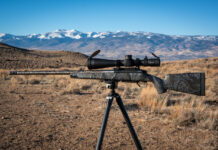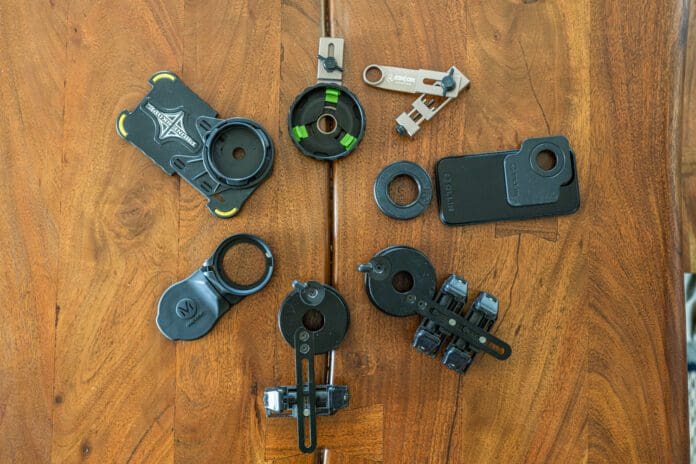Hunters have always loved documenting and sharing their hunting adventures with their family and friends. From ancient cave paintings to modern social media, hunters share their tales of success and failure in the woods.
Not everything during a hunt happens at bow hunting distances, though. Scouting, rifle hunts, and range time happen hundreds or even thousands of yards away. A great way of recording those distant events is through the magic of digiscoping.
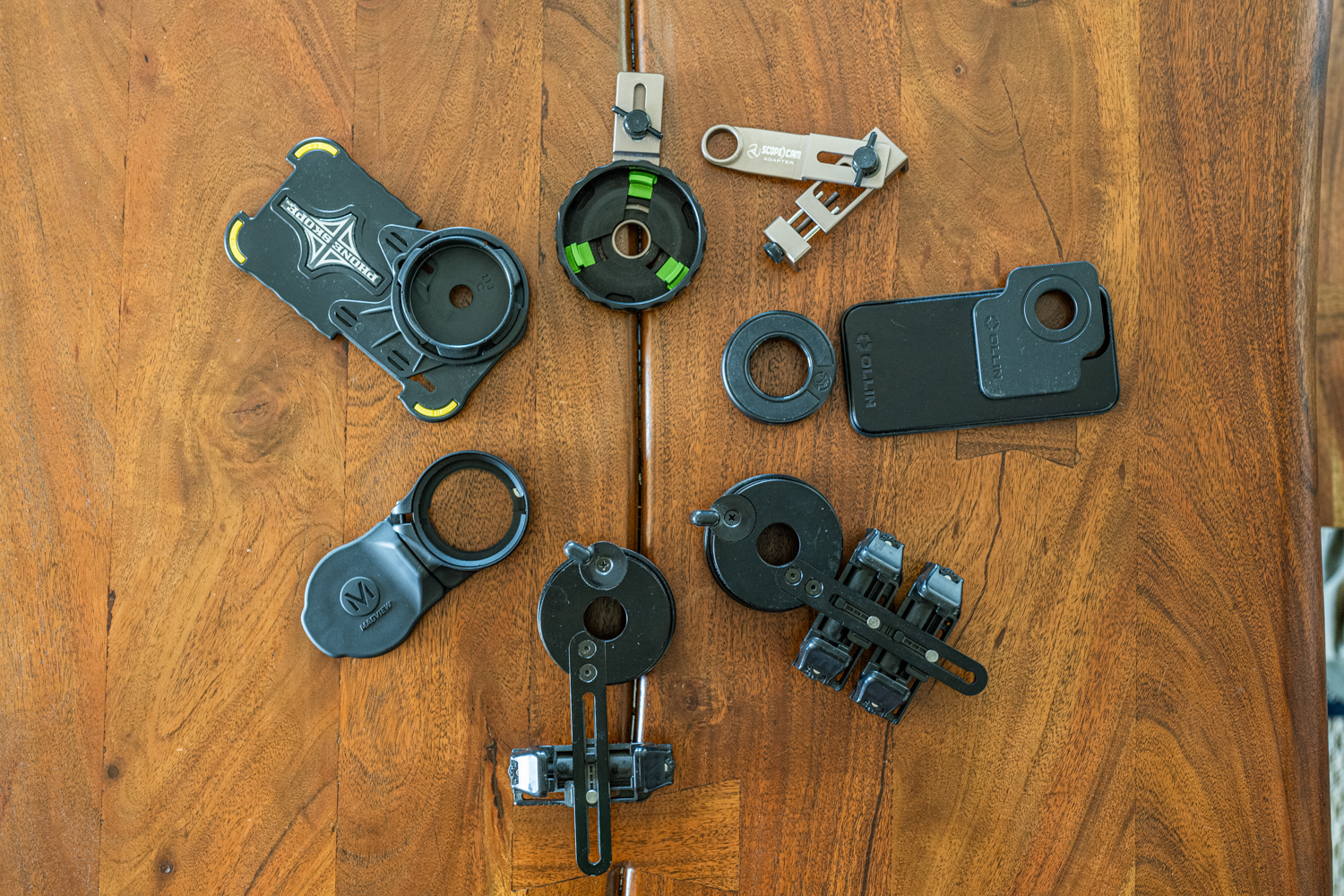
What is digiscoping?
Digiscoping is the use of a sport optic’s magnification to provide a magnified image to a digital camera in order to take photos and videos at very long distances and at very long effective focal lengths.
A high-end interchangeable lens camera with a super telephoto lens provides the best photo and video image quality at their focal length, but even the biggest, most expensive professional setups still don’t reach the effective focal lengths provided by digiscoping. Many professional wildlife photographers use 500mm or 600mm lenses on full-frame cameras. That is just not enough for photos and videos at the really long distances encountered by hunters on scouting trips, target shooting, and rifle shots on game, especially out West.
Besides the reach advantage of digiscoping, the size and weight of the system are much less than that of a full-frame camera setup, and of course, the optic will be used for more than just digiscoping.
Why a phone camera?
While many types of digital cameras can be adapted for digiscoping, phones are ideal because they are small, light, and have a combination of lens and sensor that easily adapts to the image provided by a sport optic like a spotting scope.
Even hand-holding a phone to the eyepiece of a spotter can get useable results, but to really get the most out of digiscoping, hunters are going to want to invest in an adapter. Adapters greatly reduce the frustration involved in phone digiscoping. When adjusted properly, the adapter aligns the camera lens to the eyepiece, supports the phone, and keeps everything steady.
What optics work for phone digiscoping?
Just about any optic that provides a usable exit pupil will work for digiscoping. Many digiscopers experiment with microscopes, telescopes, spotting scopes, rangefinders, and binoculars. Riflescopes present some challenges with their long eye relief, so specialized adapters are required.
Most hunters prefer digiscoping with a spotting scope. Spotting scopes are great for digiscoping because they are stabilized on a tripod, have plenty of magnification, have suitable eye relief, and hunters often already use a spotting scope.
How does a phone digiscoping adapter system work?
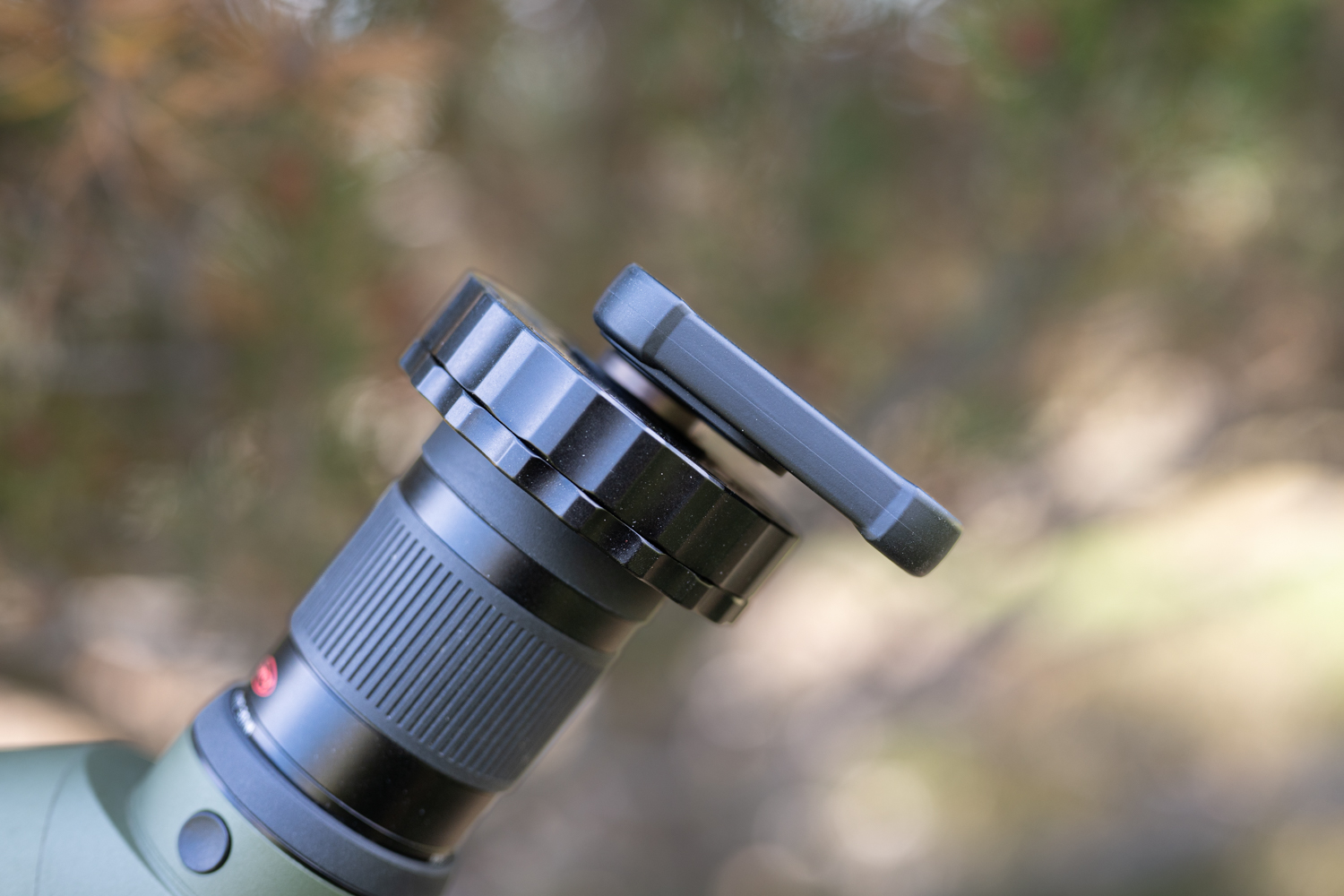
Phone digiscoping adapters work by precisely lining up the lens of the phone’s camera with the center of the optic’s eyepiece. This way, the phone camera can take a photo of the magnified image provided by the optic. Most phone digiscoping adapter systems work with two points of attachment:
- The adapter connects to the optic eyepiece.
- The adapter connects to the phone.
Adapters connect to the eyepiece either by a friction fit around the eyepiece or an adjustable system that squeezes around the eyepiece.
Adapters connect to the phone either by integrating into a phone case or by a clamp system that tightens to the phone. The phone cases are either connected mechanically or magnetically.
Testing the Adapters
I tested a number of different phone digiscoping systems by using them in the field. I repeatedly assembled and disassembled them and took photos and videos with each setup. I tested samples from five of the most well known digiscoping companies marketing to hunters. To get an idea of the pros and cons of each adapter, I tested them all on the same optic, a Kowa 883 Spotting Scope with TE-11wz 25-60x eyepiece. I also used the same phone, an iPhone 13 Pro. All of these adapters provided similar performance once mounted. That is … when used properly … they were all capable of precisely aligning the camera to the eyepiece and consequently provided similar results in photos and video. The differences ended up being cost, size, weight, ease of use, effectiveness, and versatility.
These were my conclusions:
Novagrade’s Single and Double Gripper Adapter
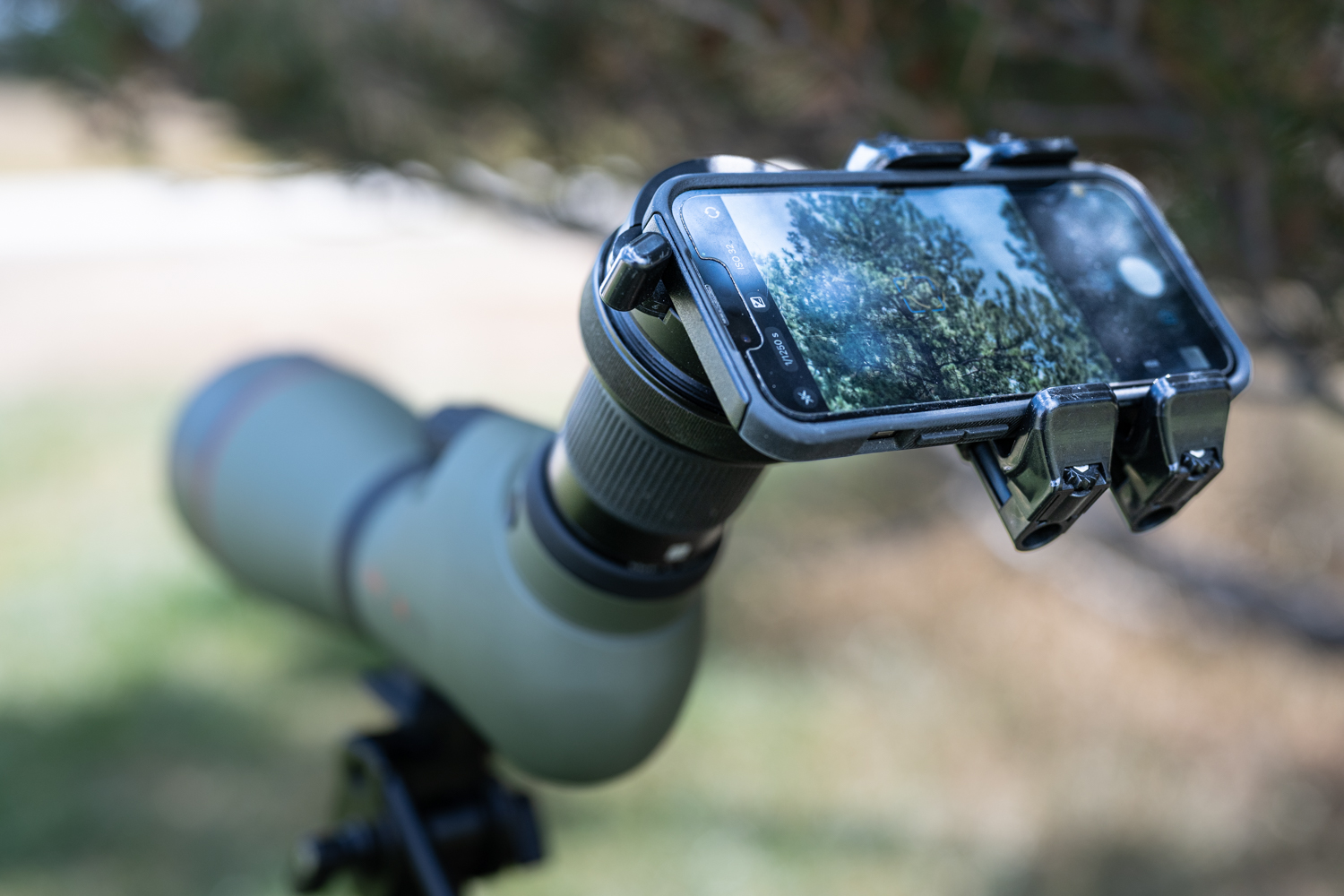
Attaching to optic
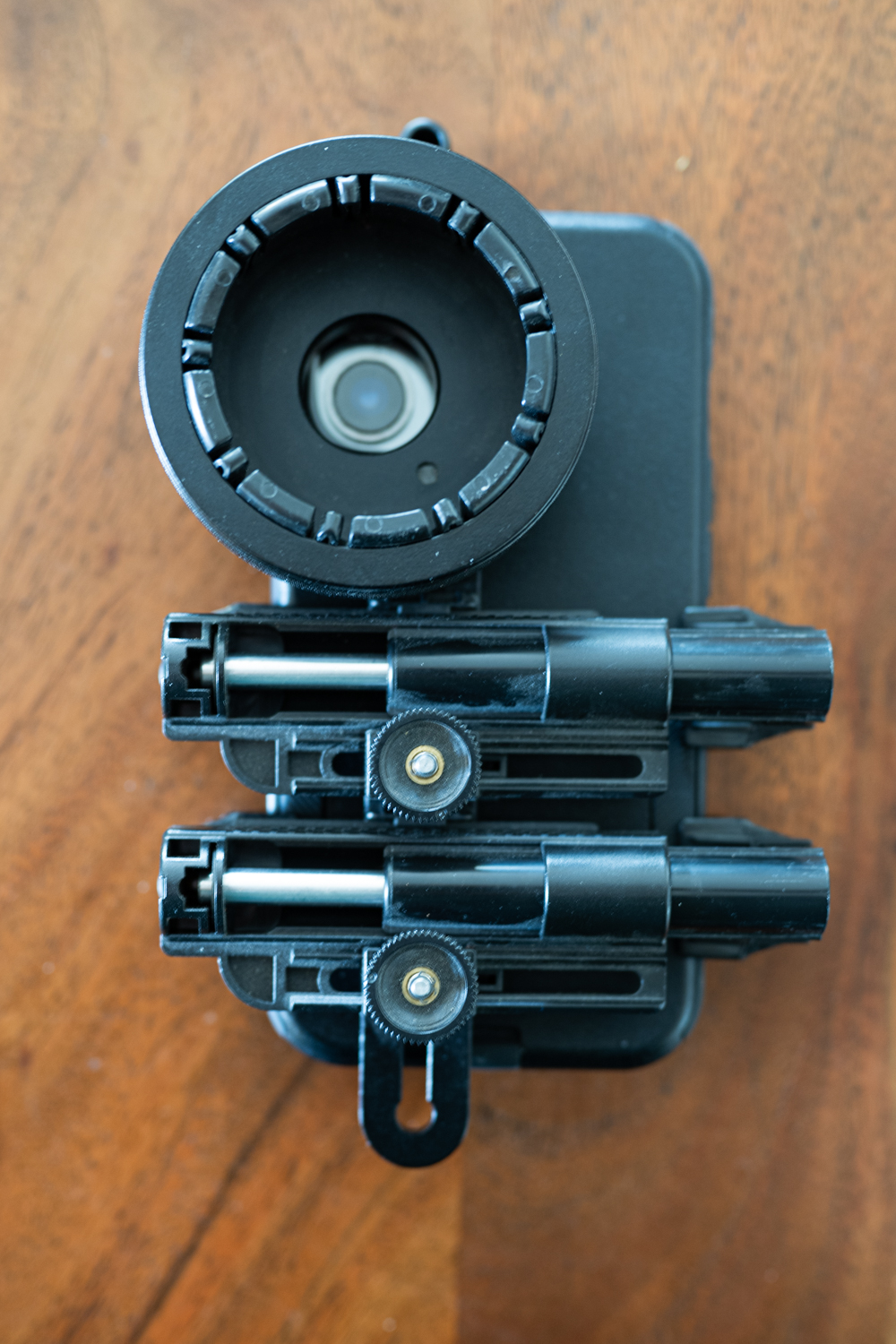
The Novagrade system uses a threaded collar that tightens down against the adapter housing through the use of various sizes of compression rings. When tightened down, the resulting connection is very secure. The standard package comes with compression rings fitting round eyepieces from 39mm to 60.75mm. Other smaller compression rings are available for even smaller eyepieces. View or purchase a Novagrade here.
Attaching to phone
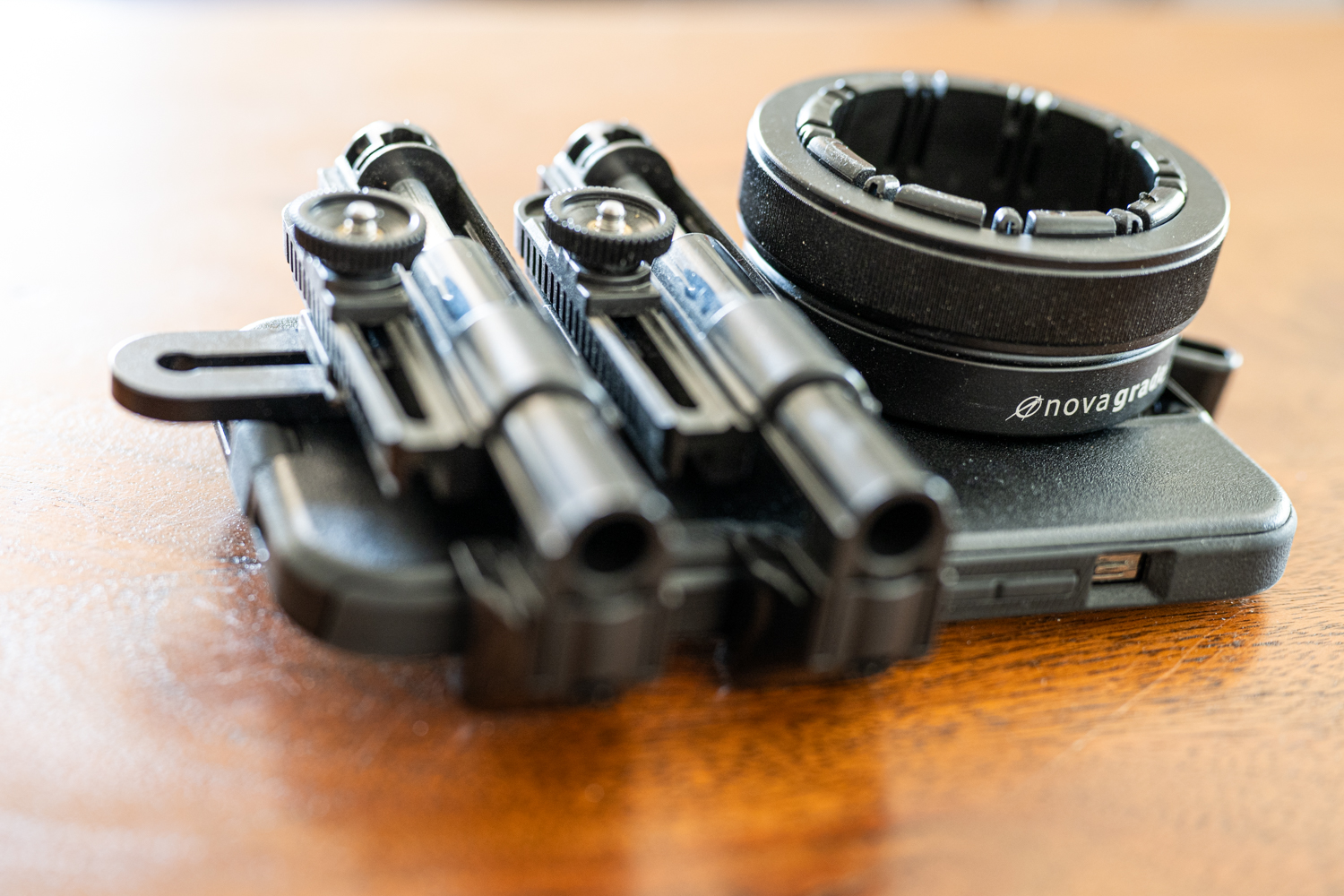
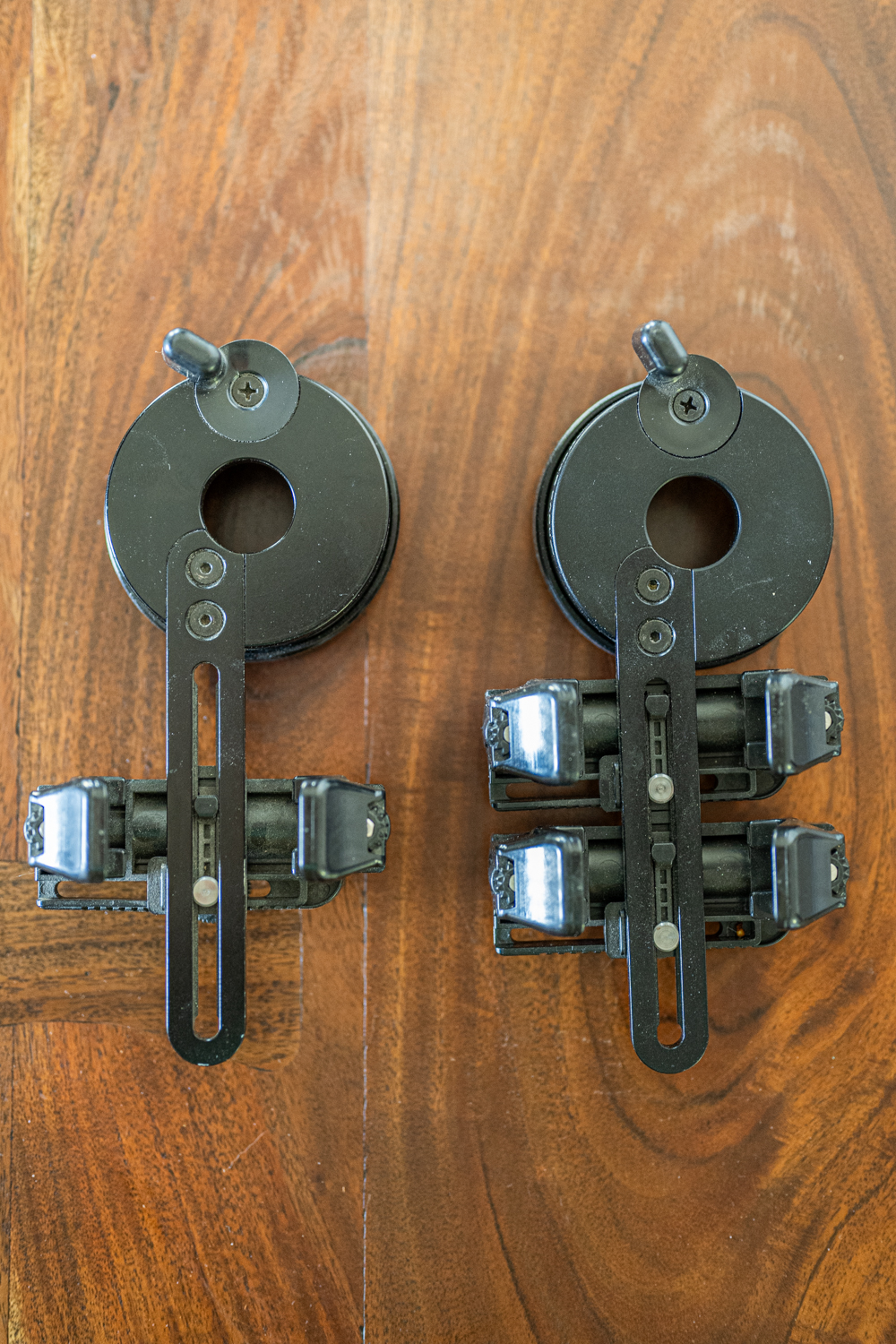
The Novagrade Phone Adapter comes in two forms: The “Single Gripper” and the “Double Gripper.” Each gripper is a spring-loaded clamp that secures the phone to the adapter. Grippers fit all smartphones and even some mini-tablets up to 110mm wide. The system versatility doesn’t stop there, however, as Novagrade even has a tablet adapter available as well.
The design allows for phones with or without a case. As the name implies, the only difference between the models is the number of grippers. The “double gripper” just provides more stability and repeatability to the system. Once mounted in the gripper, the adapter slides on two axis to align the camera lens with the opening on the eyepiece mount. Once aligned, the user tightens the x and y knobs while also securing an adjustable stop to keep the top of the phone aligned against the phone. When everything is tightened down, the phone can be removed and reinstalled to the adapter without the need for excessive realignment. The eyepiece mount tightens to the eyepiece by screwing a collar down around a compression ring insert.
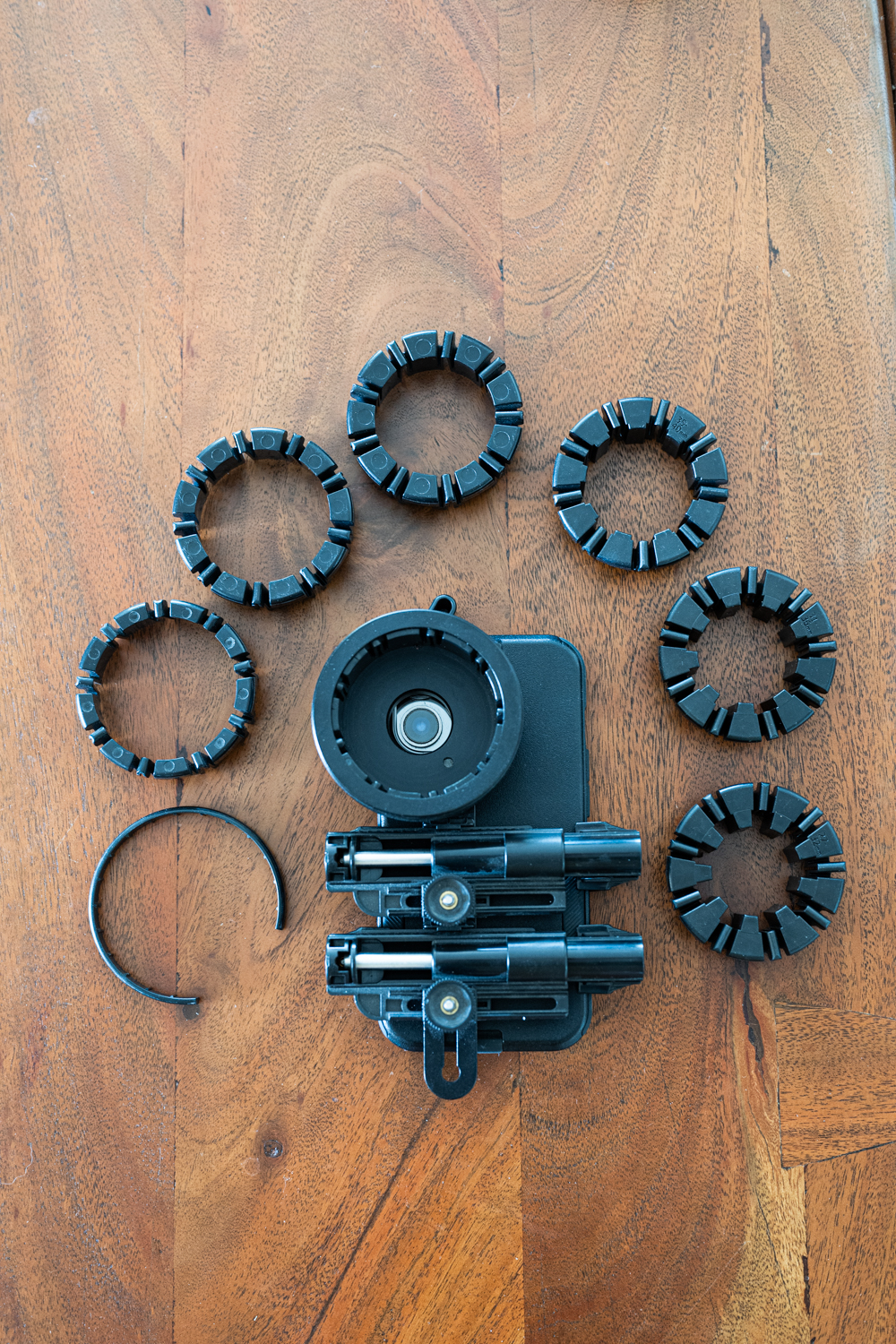
Novagrade use in the field
I have used the Novagrade adapter for years. It is extremely well built out of machined aluminum and quality plastics. The function of the adapter is very good. I do find myself occasionally having to make small adjustments to the lens alignment when reinstalling the phone. I like this adapter for its versatility. There are compression rings available for everything from microscope eyepieces to the largest spotting scope eyepieces. Of all the adapters I tried fits the widest range of phones, tablets, cases, and eyepieces. Unfortunately, that versatility comes at a weight penalty and the need to use different compression ring inserts for different sized eyepieces.
Pros
- Secure connection
- Robust build quality
- Versatility
- Uses any smartphone with or without case
- No need to buy another adapter for a new phone
- No need to buy another adapter for a new optic
Cons
- Camera alignment occasionally needs adjustment
- Size / weight
Who is the Novagrade Adapter System For?
Hunters looking for maximum versatility, use multiple phones, use multiple optics, don’t prioritize weight savings, and can put up with a little bit of fuss while adjusting alignment.
Phone Skope Digiscoping Adapter
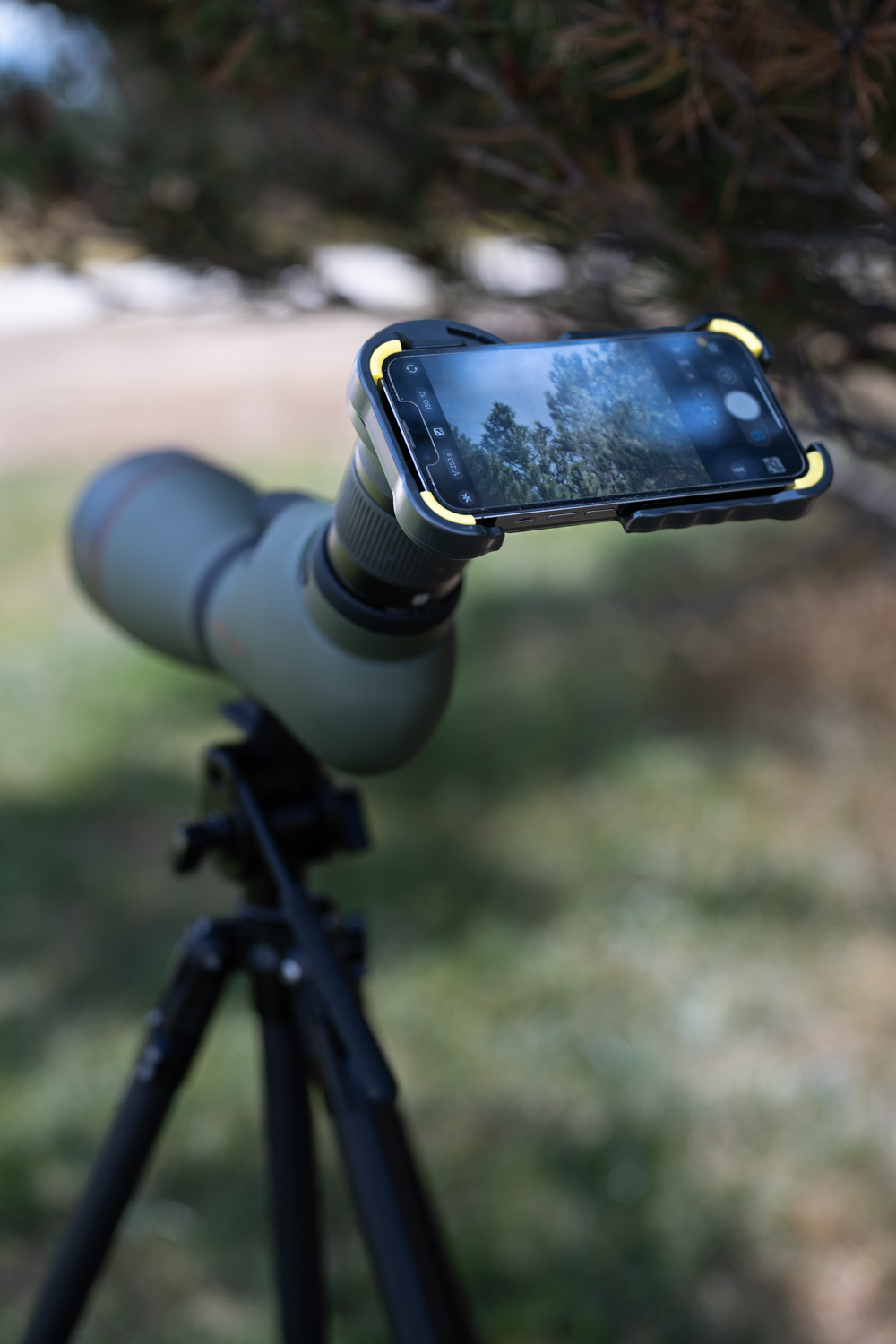
Attaching to optic
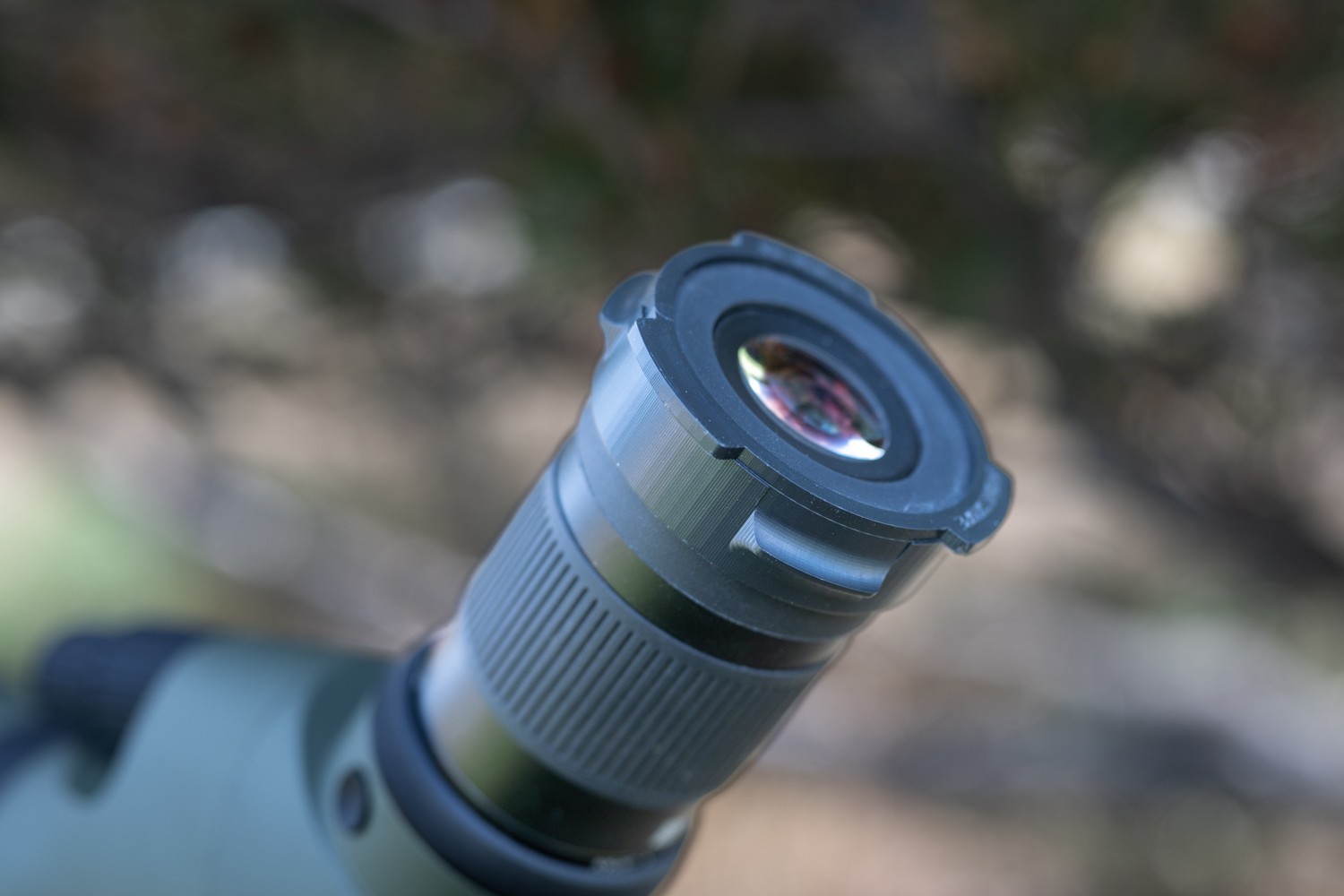
Phone Skope sells various sizes of plastic, pressure-fit “optic adapter” collars for your optic’s eyepiece. The Phoneskope website makes it easy to find the proper fit for your optic. The collar slides on the eyepiece with little effort but feels secure when fully mounted. The collar has a bayonet-style attachment system for attaching and releasing to the phone case with a twist. For those that want to leave the collar on the optic while viewing, a cap is available that mounts to the collar to prevent damage to the ocular lens. See or purchase Phone Skope here.
Attaching to phone
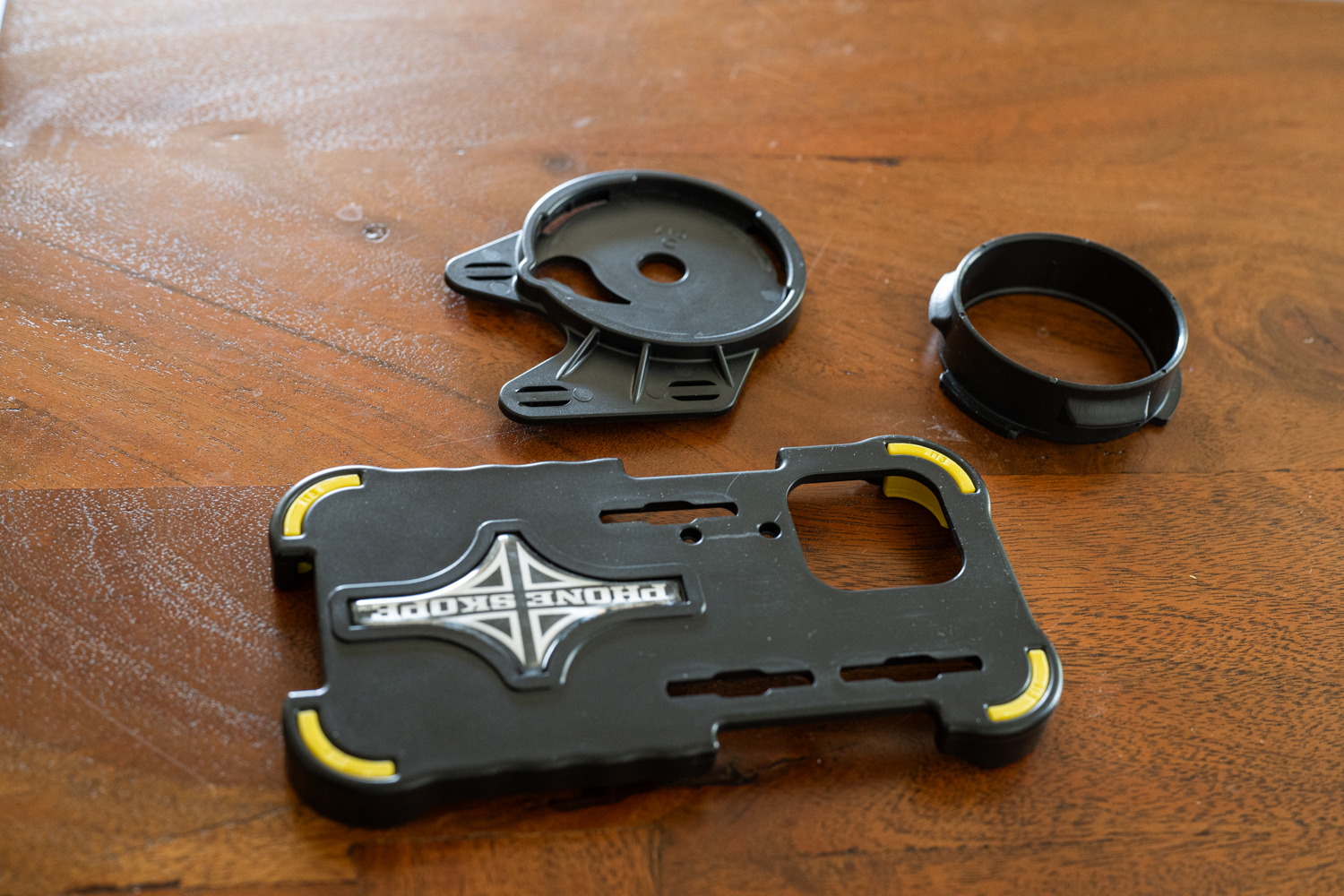
The Phone Skope system uses Phoneskope’s own proprietary case for your model of phone. This is a sturdy impact-resistant plastic case with cushioned bumpers at the four corners. The iPhone 13 Pro case I tested has a sliding, removable bracket included that can position the adapter over the 1x or 3x telephoto lens on the iPhone 13 Pro. Once mounted to your phone, you just twist the bracket on the optic adapter mounted on your scope.
Phone Skope Use in the Field
Phone Skope is so established in the hunting market that its brand name is now interchangeable in hunting jargon for phone digiscoping, whether or not hunters use the Phone Skope brand product. I found the Phone Skope system fast and easy to use. The optic adapter can be left on the scope, which speeds up deployment. There is no fuss in getting the optic aligned. It just works. Glassing with the optic adapter mounted is pretty easy, although I did prefer glassing with just the standard eyecup.
The Phone Skope case provides some impact protection with cushioning at the edges and plastic in the back. The edge cushions have a small lip that retains the phone in the case. It seems like the phone could come out of the case accidentally, but I didn’t have any issues with it in the field in actual use. The Phone Skope is the lightest option in this roundup, including the case.
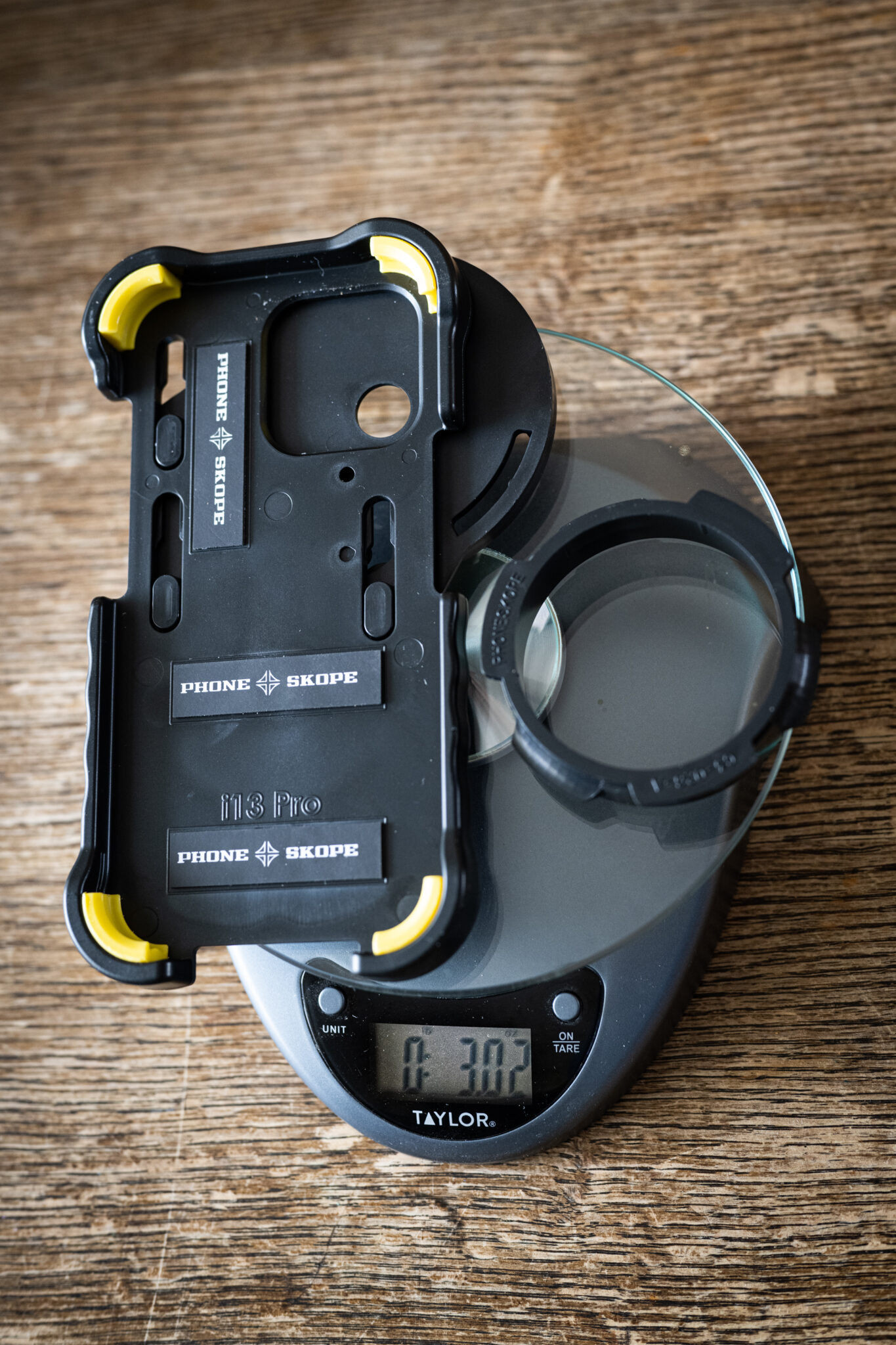
Pros
- Extremely lightweight and compact
- Wide range of fits available
- Quick and easy to use
- Repeatable alignment when removing/mounting
- Low cost of entry
Cons
- Optic adapter and phone case are model specific
- Requires use of Phone Skope’s proprietary phone case
- All-plastic construction
Who is the Phone Skope Adapter System For?
Hunters that are looking for a simple, easy to use system that is magnet-free and ultralight.
Ollin Digiscoping Adapter System
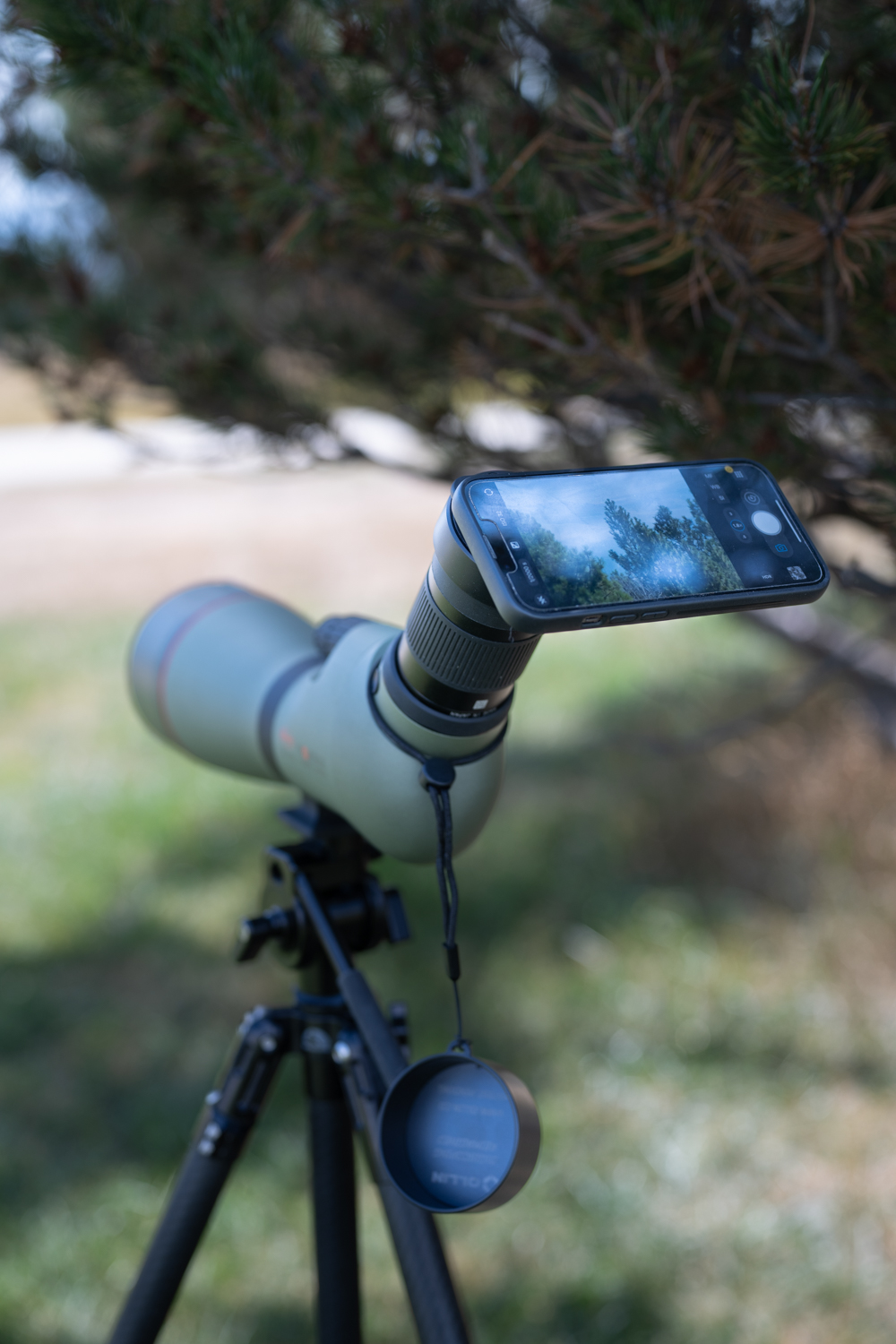
Attaching to optic
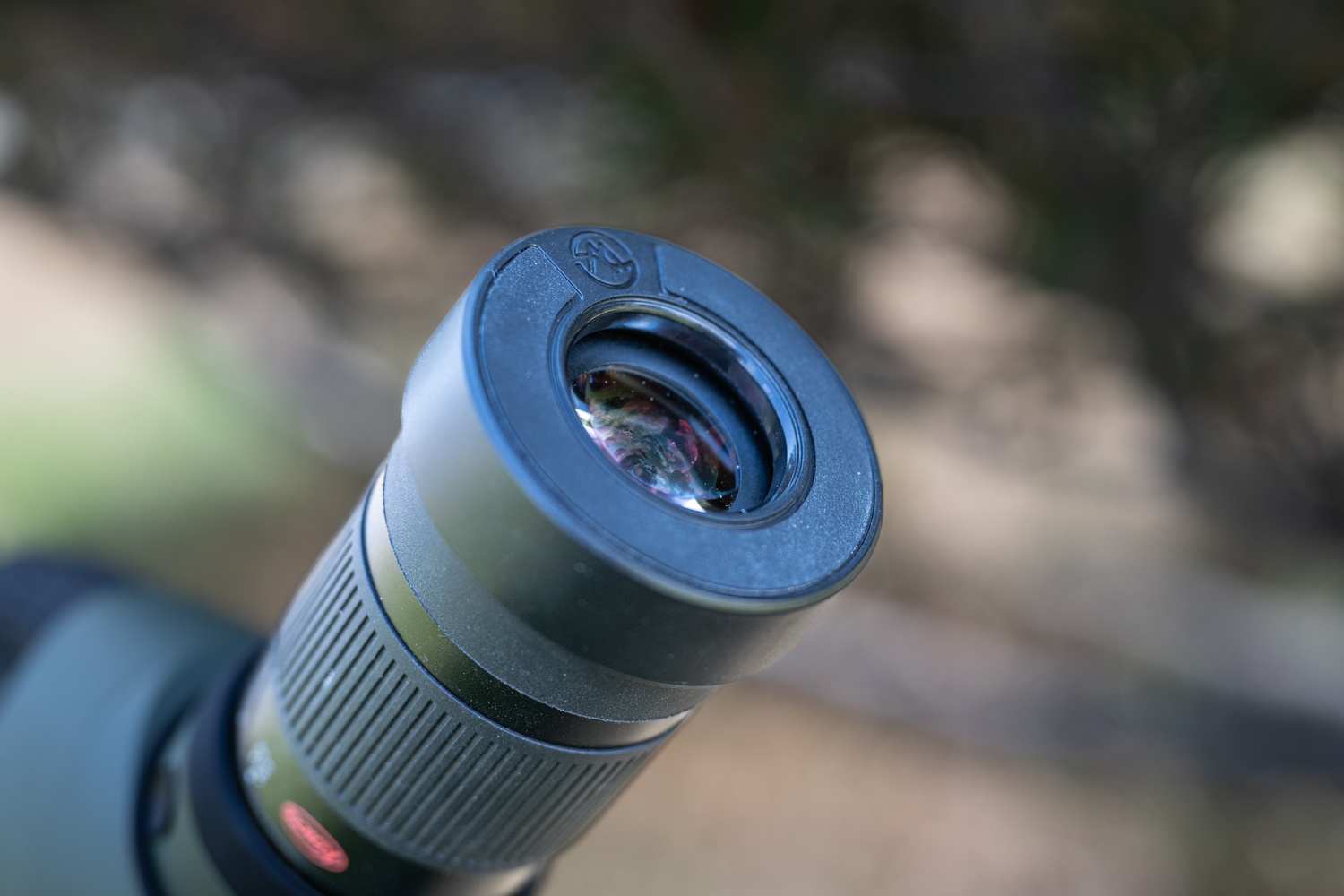
The Ollin is a magnetic digiscoping solution. The eyepiece adapter pressure fits over the eyepiece with the Ollin logo straight up and is meant to be left on the eyepiece even while glassing. The adapter includes a magnetic tethered eyepiece cover that protects the eyepiece when not in use. I found the eyepiece adapter pretty easy to glass with, but it does take up a few millimeters of eye relief and increases the width, changing the viewing experience from the bare eyecup. Depending on the scope model, some eyeglass wearers might have trouble with the change in eye relief. See or purchase the Ollin digiscoping adapter here.
Attaching to phone
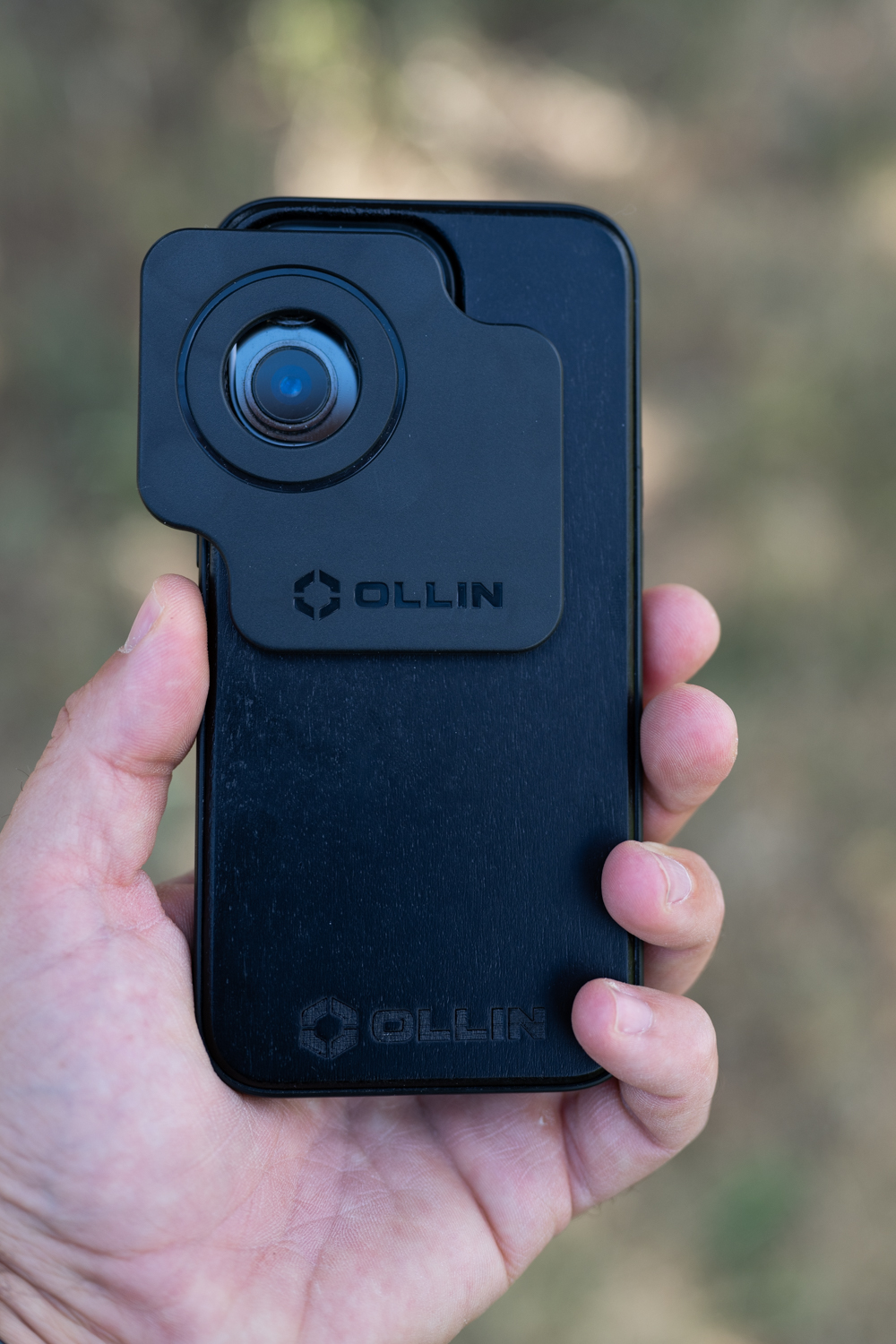
The Ollin requires use of their phone case with a magnetic plate attached. The magnets in the plate are situated in such a way that an 1/8-turn rotation releases the magnetic field. So the user just puts the phone in the adapter plate vertically (portrait) or horizontally (landscape), and releases the adapter with a simple quarter-turn. The eyepiece cover attaches and comes off the same way. The magnets self-center the camera lens automatically. Only the 1x camera lens is available.
Ollin use in the field
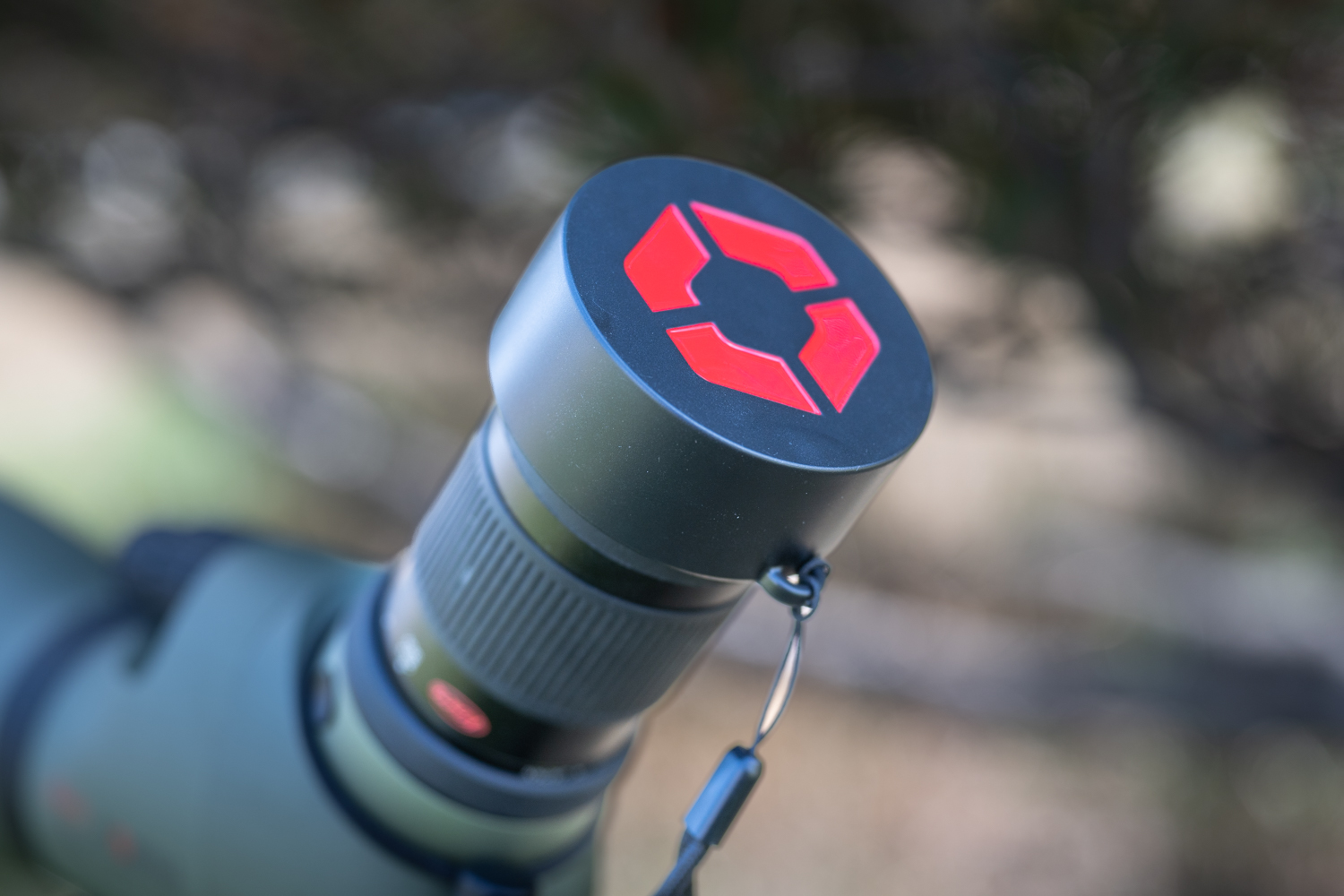
The Ollin is simply the fastest and easiest way to get digiscoping in the field. Once your phone is in the Ollin case and the eyepiece adapter is fully seated on the eyepiece, everything is easily and perfectly aligned in an instant.
The Ollin case is thin and light, providing moderate protection to the phone. The Ollin’s magnetic cap provides fast, secure protection for the ocular lens when not in use. The magnet is on the phone case, which may interfere with the phone’s internal compass. I tested this, and my phone seemed to keep a proper magnetic North reading while in the case, but the hunter should be aware of this possibility if they use their phone for directional navigation.
Pros
- Extremely fast and nearly fool-proof to use
- NO fiddling with alignment
- Lightweight
- Easily switches from landscape to portrait orientation
- Magnets hold strong but release in an instant with a small twist
Cons
- Eyepiece adapter and phone case are model specific
- Requires use of Ollin’s proprietary thin phone case
- Higher price
Who is the Ollin Adapter System For?
Hunters looking for the fastest, easiest way to get digiscoping.
Scope Cam Gen 2 Universal Adapter
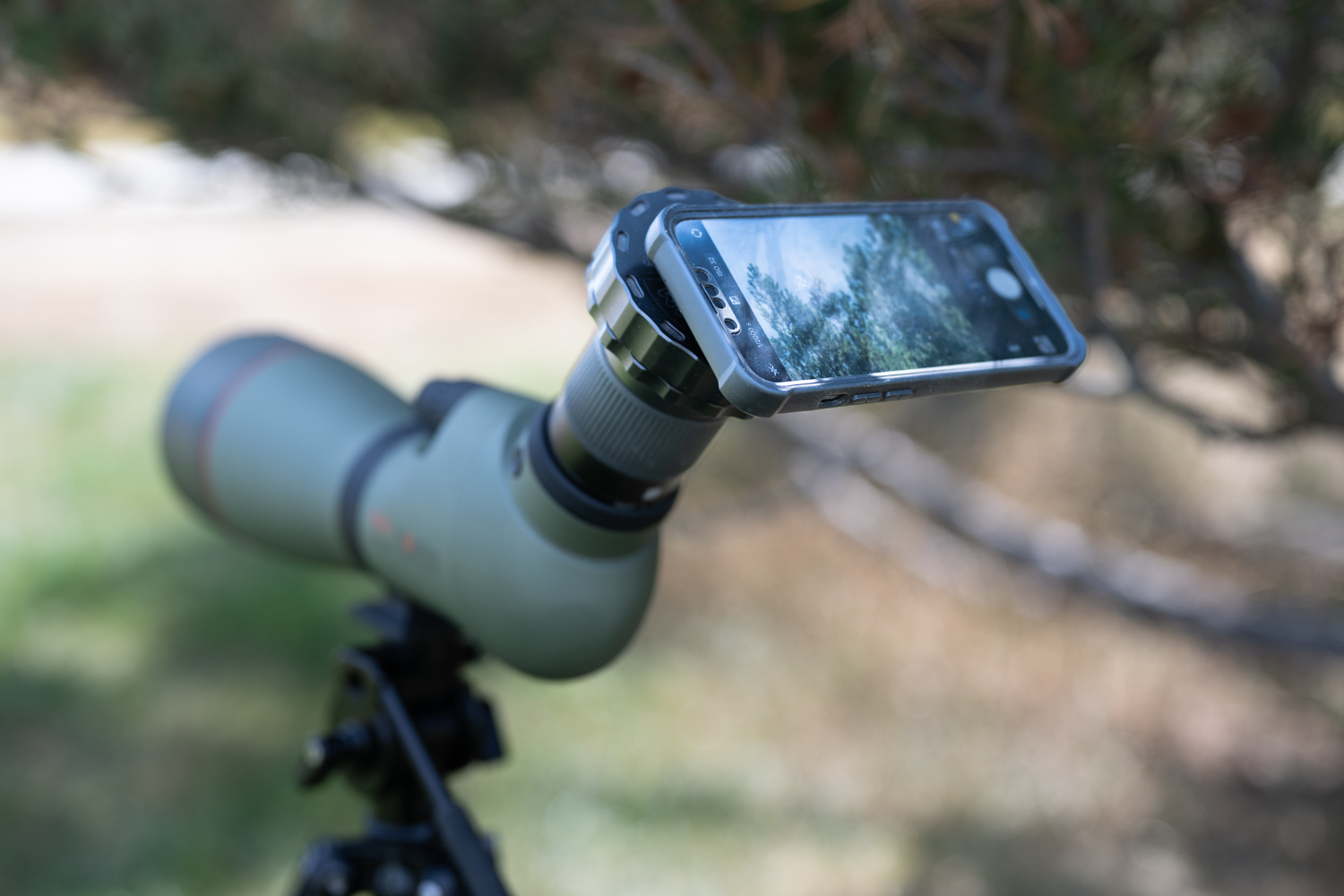
Attaching to optic
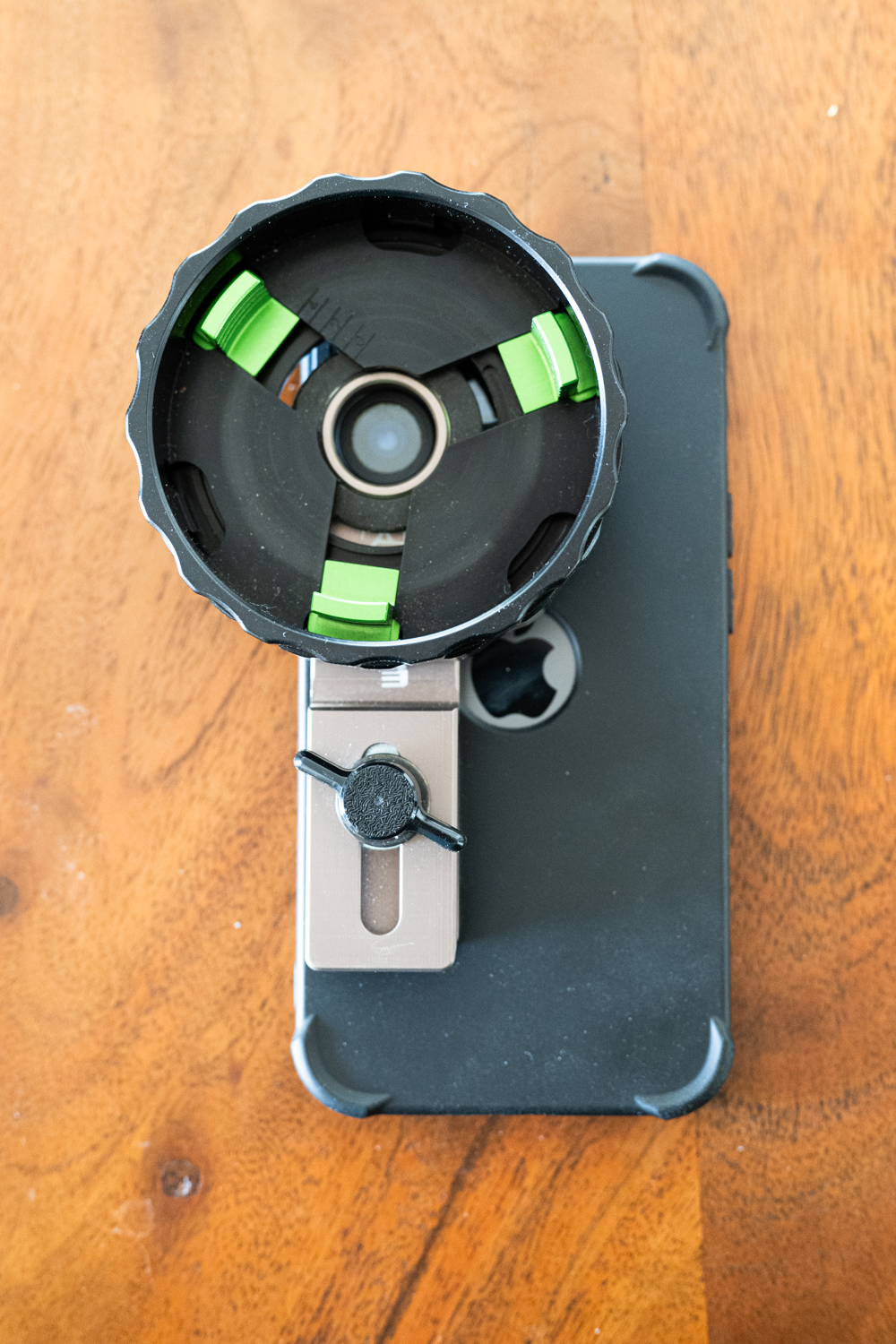
The heart of the system is the Gen 2 Universal Adapter, which attaches to the eyepiece by three adjustable curved tabs that squeeze the eyepiece. I found attaching the adapter to the eyepiece to be fairly quick, easy, and secure. The adapter works on eyepieces from 1.4” to 2.4” in diameter. The adapter connects to a 34mm threaded mount on the phone. See the ScopeCam or purchase here.
Attaching to phone
Scope Cam gives the user a menu of 34mm mount choices for attaching to your phone.
- Two phone case options ScopeCam branded ($37) and an Otterbox option ($60) with tab installed by ScopeCam.
- Smart Bracket SB-1 Universal bracket. This grips the user’s phone (with or without case) with a machined aluminum bracket.
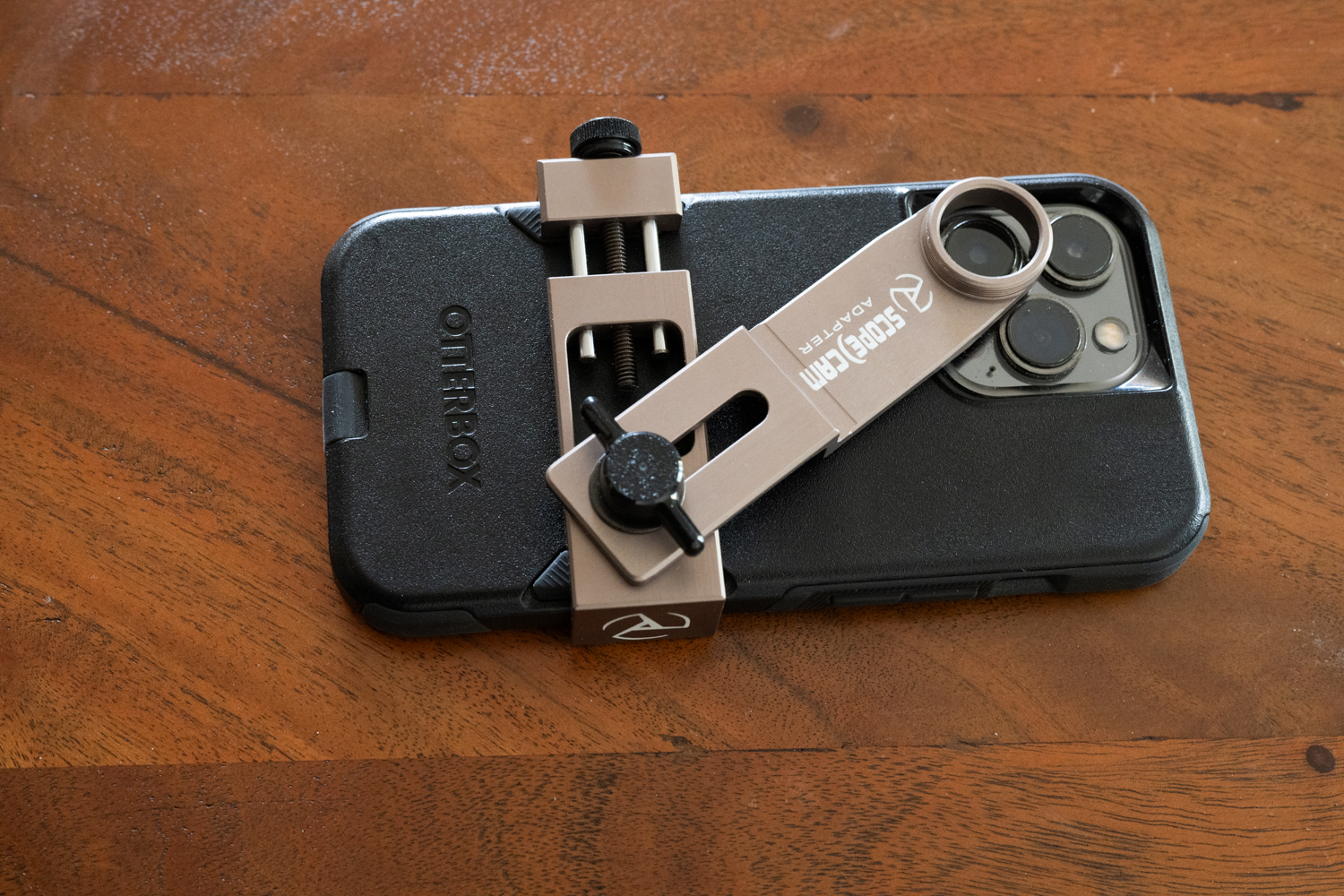
- Mag Plate magnetic universal adapter. This is a clever implementation where the user can quickly attach and detach the mount adapter bracket by bonding a metal plate to their phone case. The adapter then attaches via magnet to the plate.
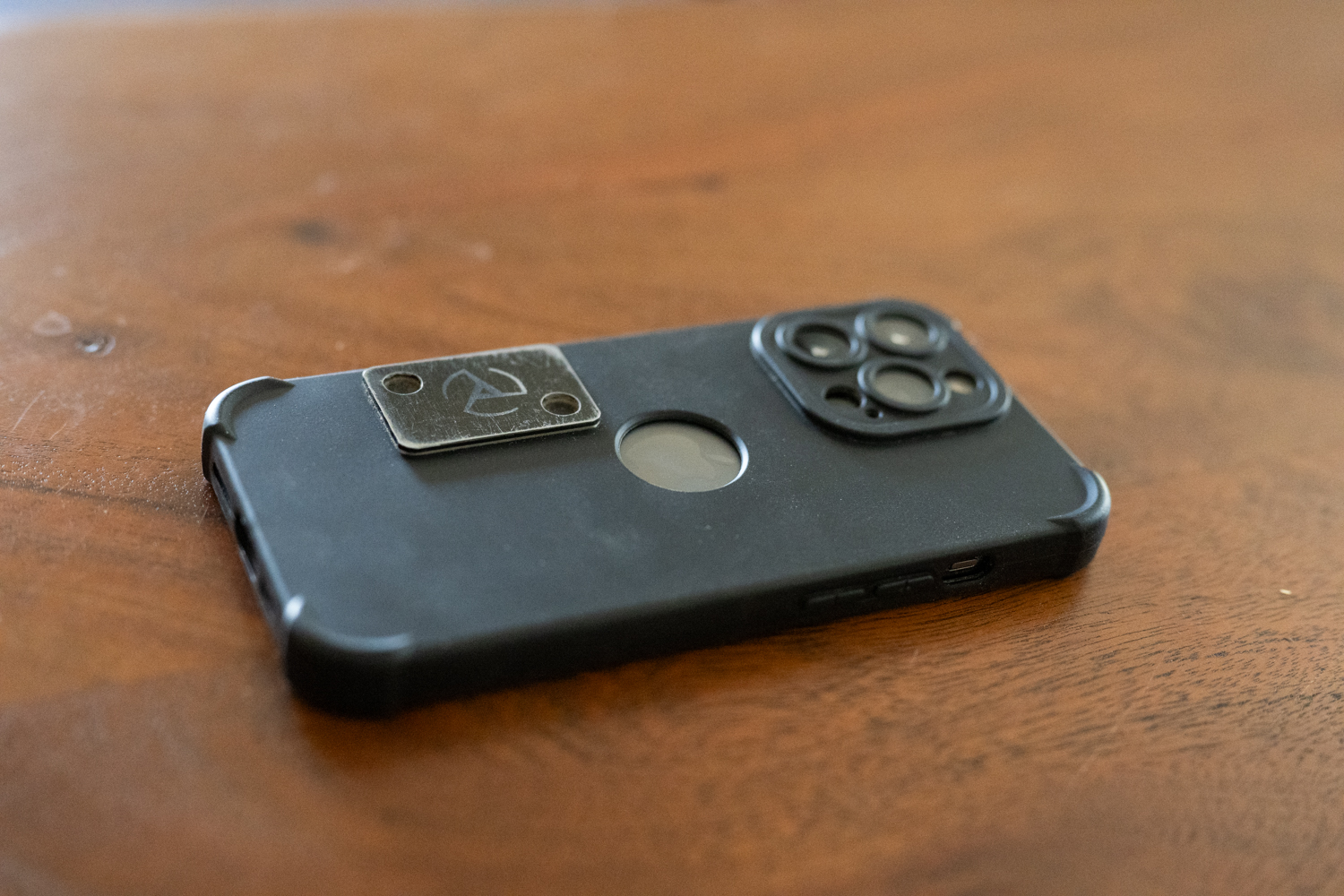
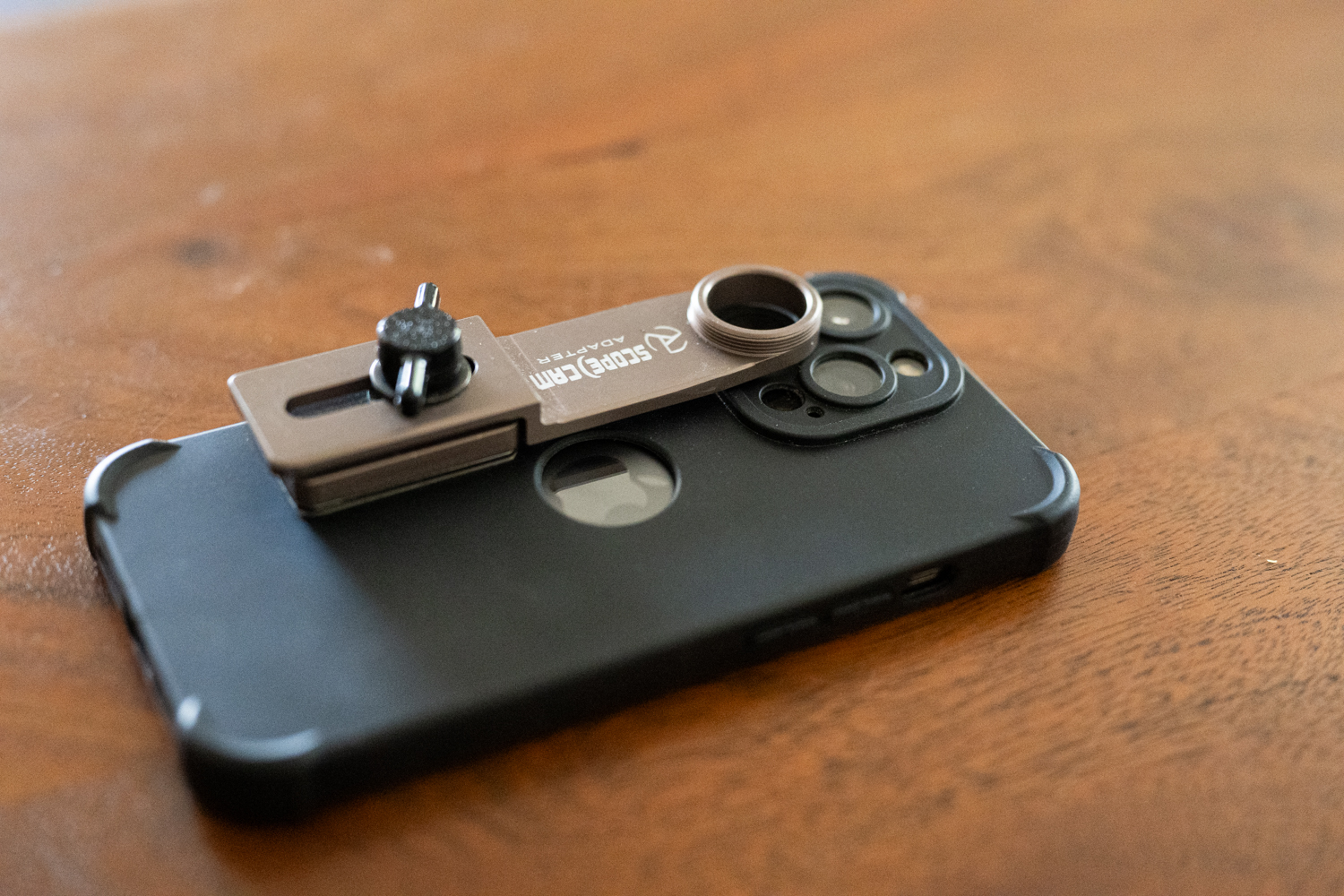
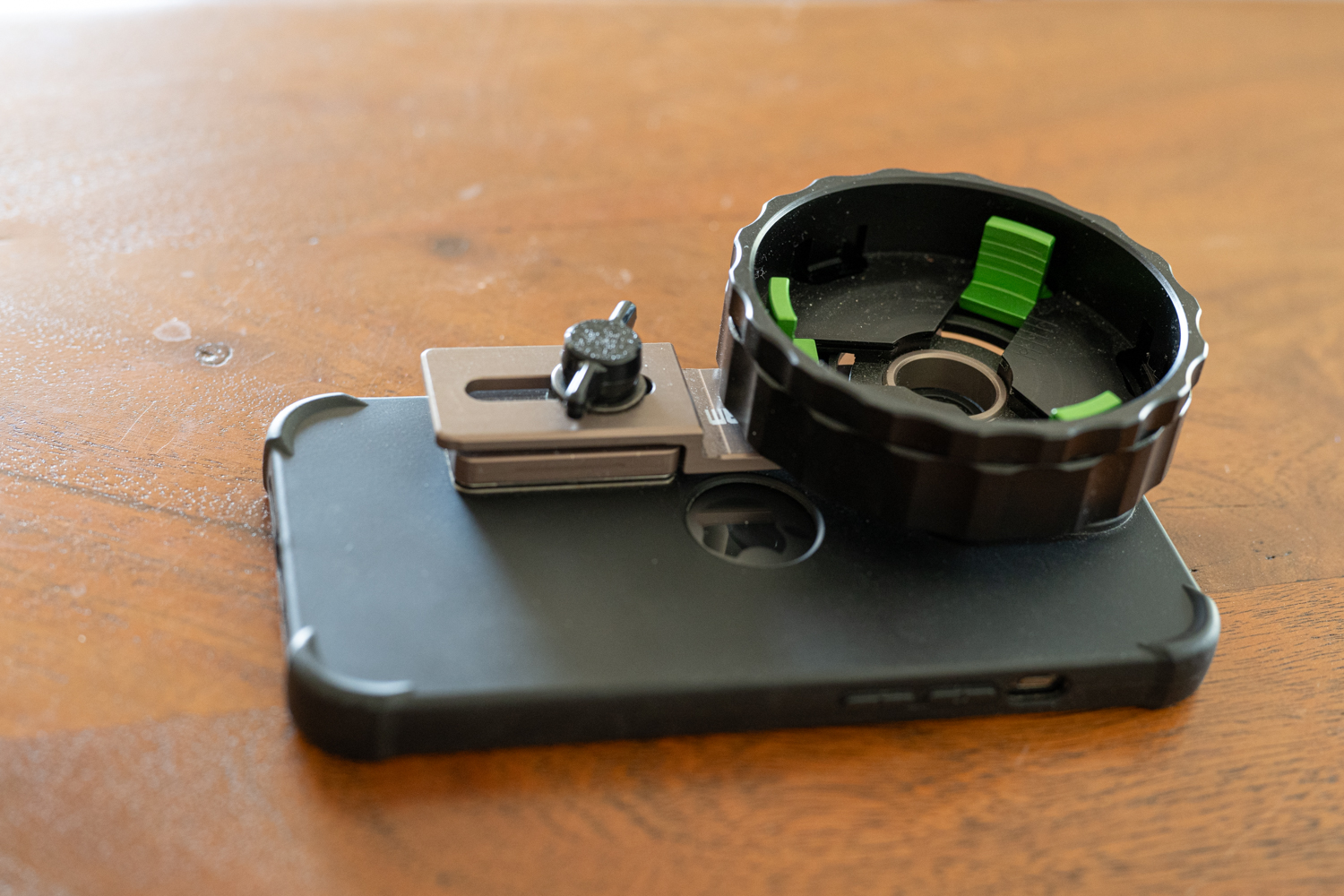
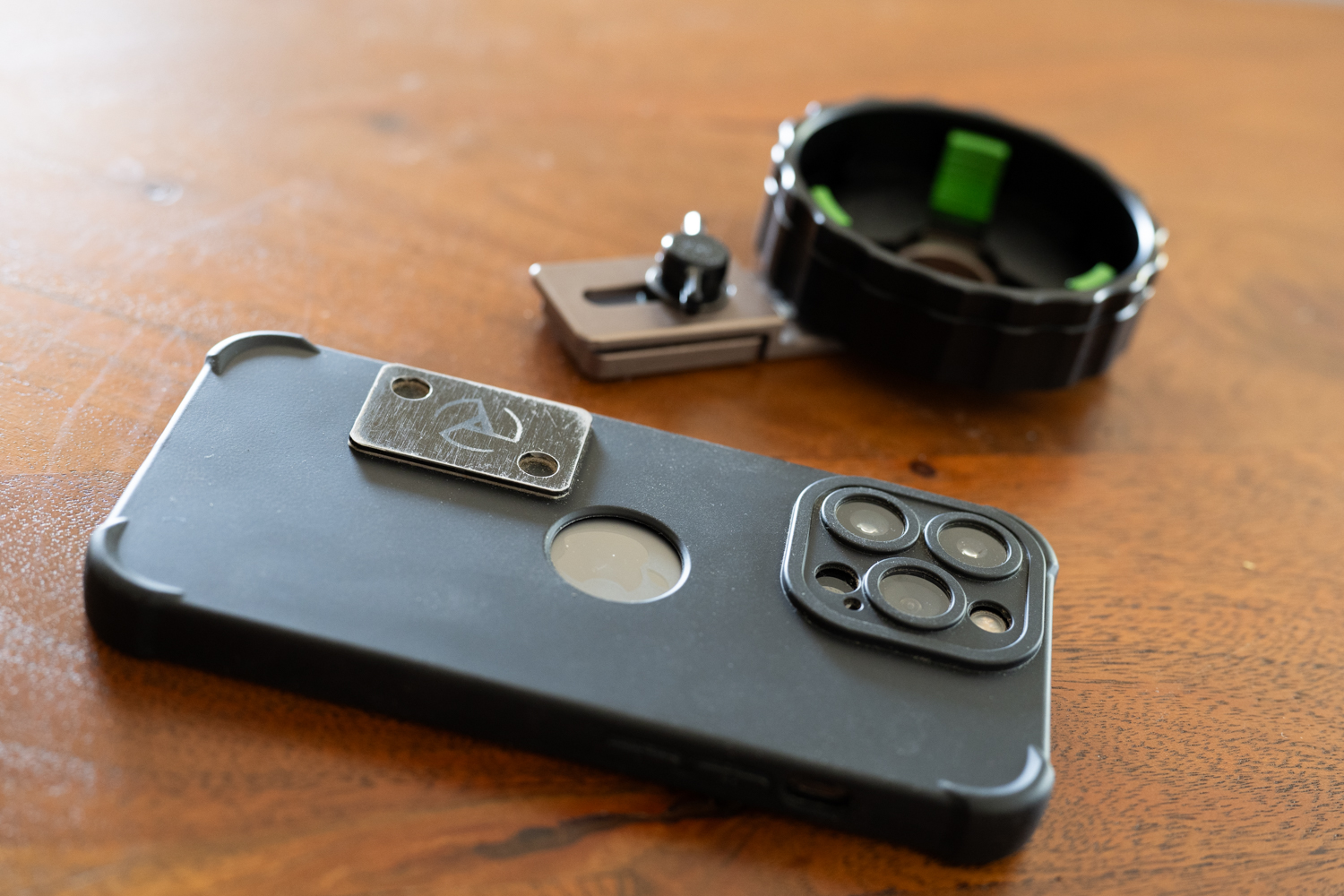
ScopeCam use in the field
I used both the smart bracket and Mag Plate. The smart bracket was versatile and allowed just about any phone and case combination to be used. It was a little bit finicky in getting the camera lens centered perfectly each time. The Mag Plate was my favorite. First, the user adheres the metal plate to the phone case with two-sided adhesive tape. Once adjusted the post-and-hole design on the plate aligned the adapter perfectly for use with the Gen 2 Universal Adapter. I could leave the adapter screwed to the bracket and pop it on and off my phone case in a second. Getting a new phone or case is pretty easy as ScopeCam offers new plates for $10 and even just the precut adhesive tape ($1) for reusing the plate from your old case. The 3M double-sided tape adhesive held extremely well and is still bonded to my case after months of use.
All of the Scope Cam brackets and adapters are high quality anodized and machined aluminum.
Pros
- Durable, Quality Construction
- Versatile
- Various options for attaching phone
- Easy to Use
- Gen 2 Adapter provides a strong hold on eyepiece
Cons
- Light, but not the lightest
- Fast, but not the fastest
Who is the Scope Cam Adapter System For?
Hunters looking for the “just right” digiscoping system. Scope Cam’s system combines all of the attributes of price, versatility, speed, ease of use, and durability into a compelling digiscoping option.
MagView S1 Discoping System
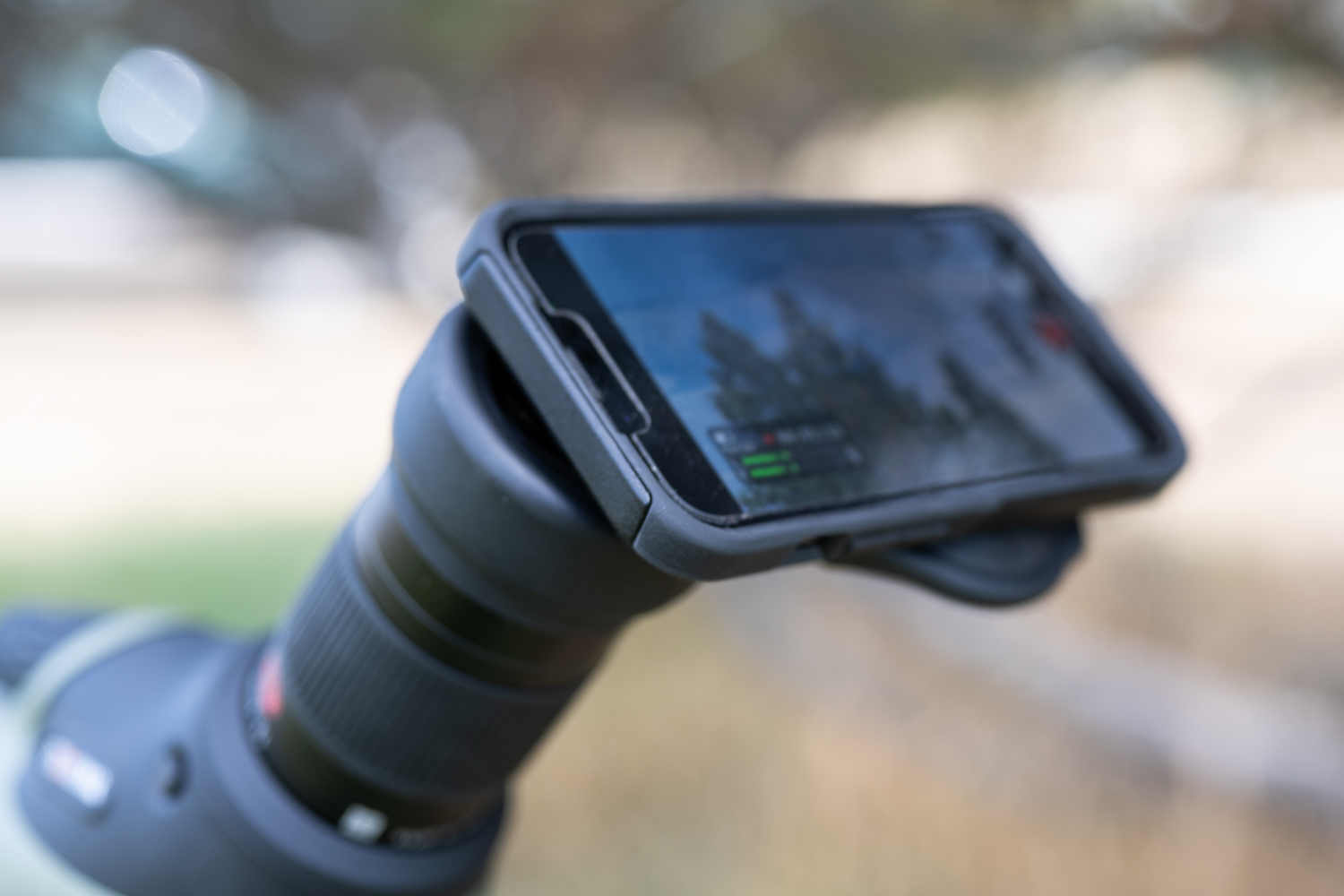
Attaching to Optic
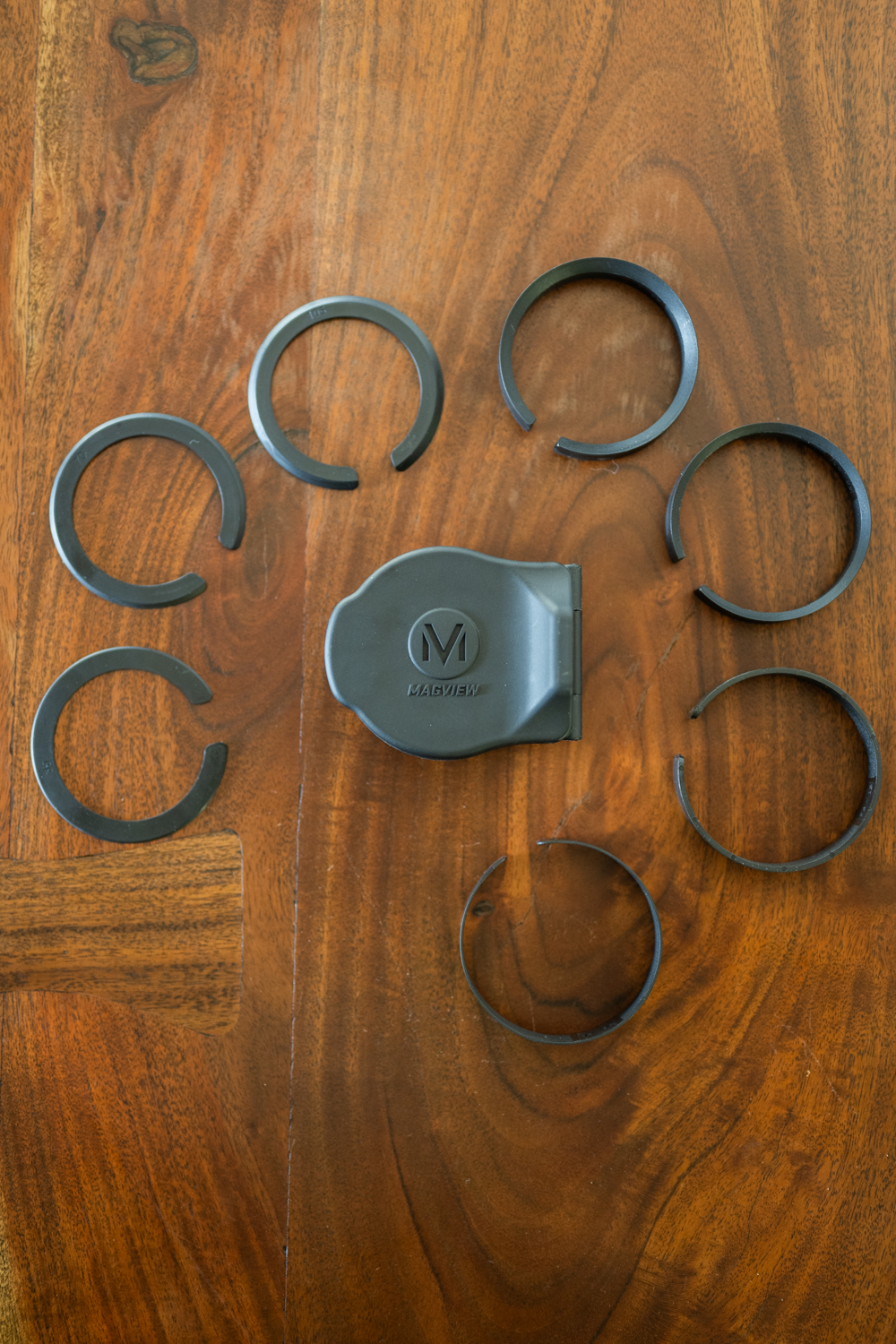
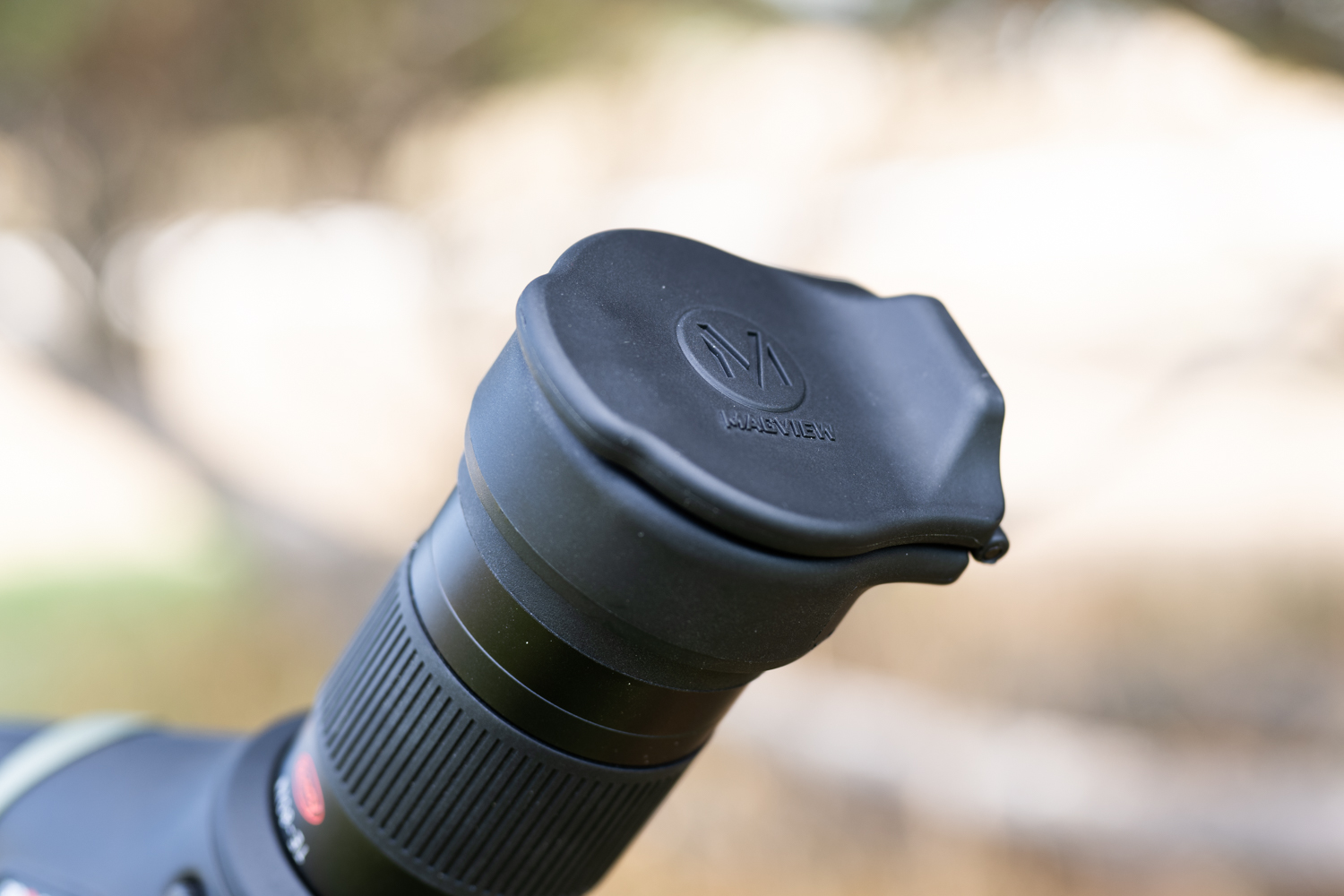
Magview is another fast magnetic digiscoping option. The S1 magnetic adapter attaches to the scope’s eyepiece and is designed to be left on for observation use. The kit arrives with several “eye relief spacers” as well as “sizing rings.” The user chooses one of each to get a snug fit on the eyepiece and tightens the adapter to the eyepiece with the included Allen wrench. The adapter has an integrated, hinged, magnetic cover that protects the ocular lens when not in use. The hinged cover serves as the magnetic attachment for the phone case when flipped open. Slick. When properly mounted, the S1 has a slightly bigger profile than the Ollin. View the Magview or purchase here.
Attaching to the Phone
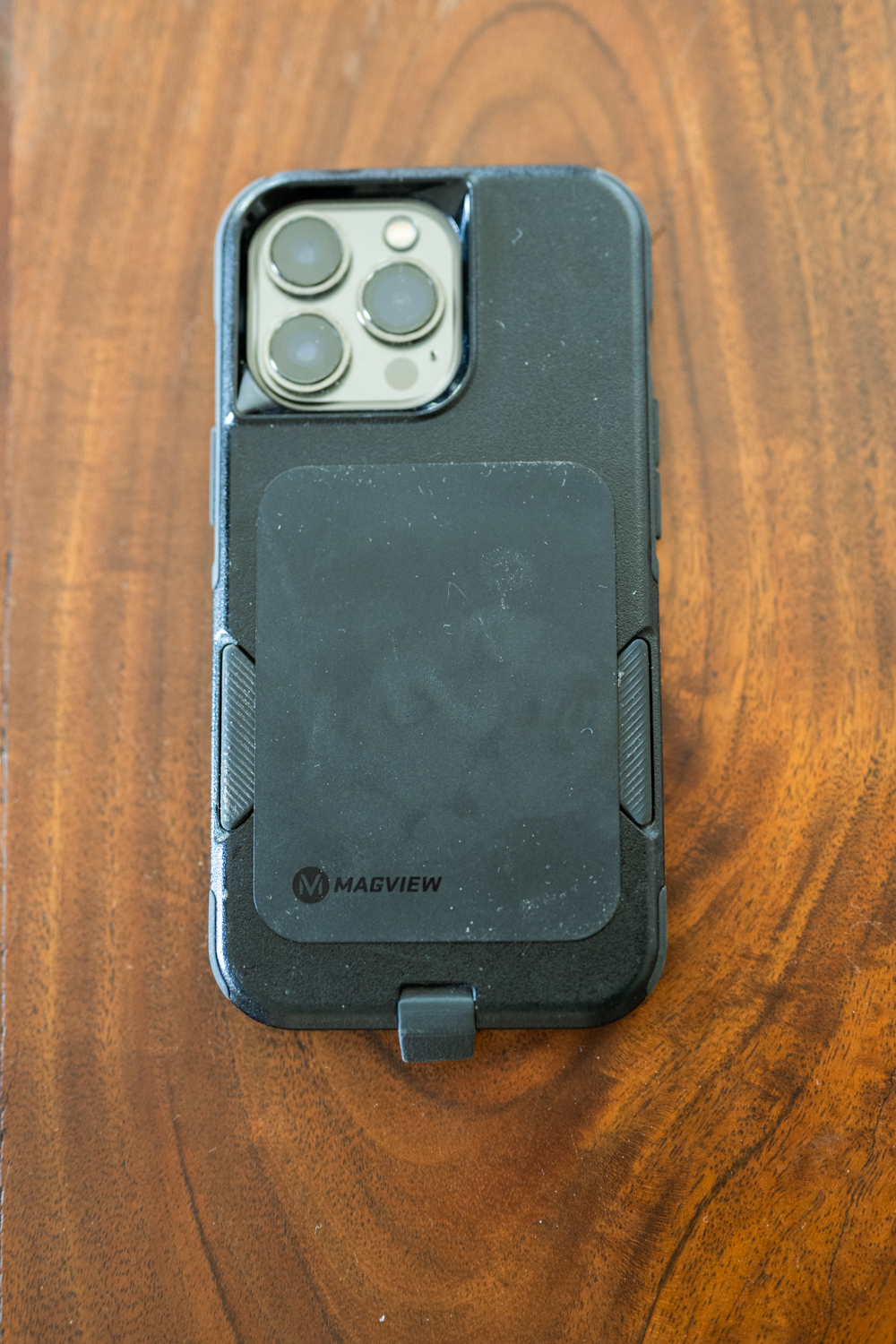
Magview supplies a steel plate with adhesive to attach to the back of any flat phone case. Once attached, the user can just hold the case up to the S1, and the case attaches firmly to the adapter. The user needs to align the camera to the exit pupil manually while attaching the phone, or slide the phone while connected to get the proper alignment. MagView sells additional plates for 15 bucks if you decide to change phones or cases. The plate adheres well and adds little thickness or weight. This system keeps the magnets on the optic, and away from your phone when you aren’t digiscoping. Unfortunately, my iPhone 13 Pro could NOT wirelessly charge with the plate attached.
Magview S1 In the Field
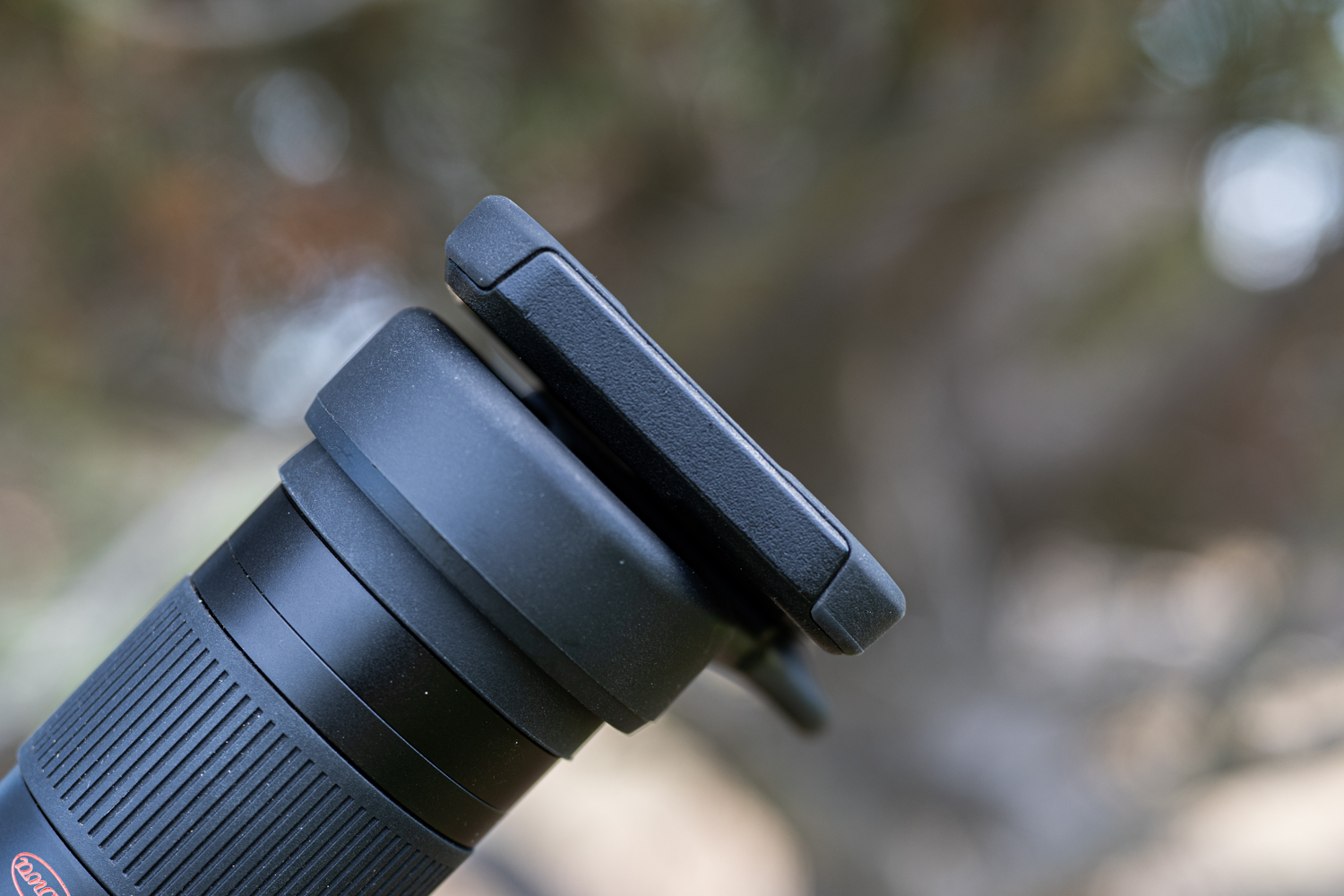
The MagView S1 was pretty fast to implement in the field. The integrated lens cover feature was convenient, although some left eye dominant users may find it gets in the way. I am left eye dominant and simply twisted out the eyepiece, which rotated the cap up, and gave me enough room for my nose on the right side of the eyepiece. The one downside to the MagView is that it doesn’t align to the eyepiece automatically like most of the other adapters, and it takes some practice and fiddling to get the lens and camera lined up precisely.
Pros
- Lightweight
- Quality Construction
- Fast deployment with practice
- Magnets are on the adapter, and not on your phone
- Convenient lens cover
Cons
- Does not auto-align to the optic.
- Plate interferes with wireless charging
Who is the MagView S1 Adapter System For?
Hunters looking for good lens protection and a fast magnetic attachment system … and can deal with fussing around with alignment.
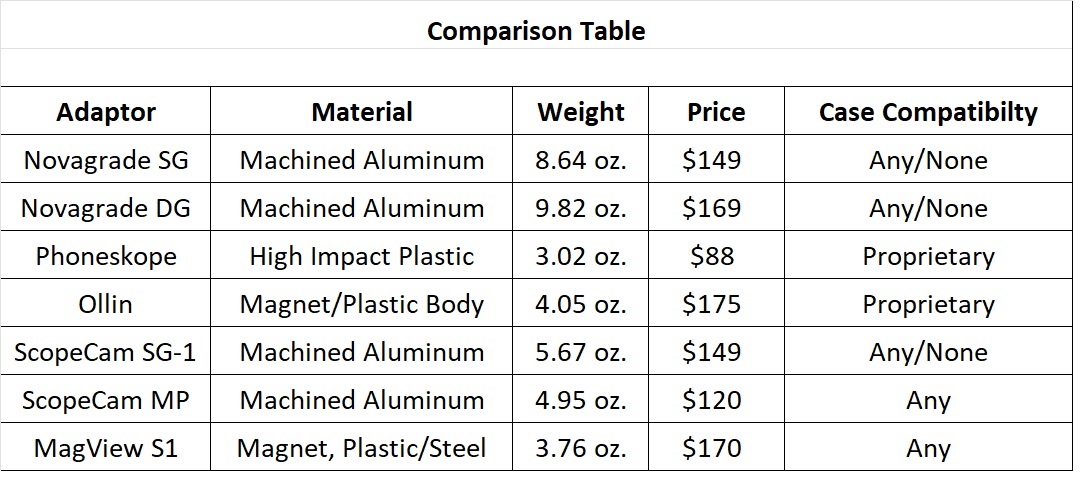
Phone Digiscoping Tips
Get the App
One issue many digiscopers have is that their phone’s standard camera app wants to automatically switch camera modules when the phone senses it is getting close to the eyepiece or the light level falls. The fix to this is getting a third-party app that lets you manually select the camera lens you want to use. Several of the above digiscoping companies have their own digiscoping apps that support this feature and work pretty well. Personally, I use an app called ProCamera for iPhone. It lets me select the camera, do manual exposure when needed, and manually focus. It also lets me record RAW camera files for post-processing.
Use the 1x Camera
I have tried all of the iPhone 13 Pro camera lens options (0.5x, 1x, 3x) for digiscoping. All of them will work, but I generally get the best quality from the 1x camera and just pinch to zoom a little to remove vignetting.
Try Video
I find it easier to get high-quality phone digiscoping images with video over still images. I like video anyway, but I will even often get better results pulling 8-megapixel frames from 4k video rather than taking stills originally.
Use a Timer
Stability is essential for digiscoping, so make use of your camera timer to remove as much shake as possible when recording still images.
Conclusion
Hunters have a plethora of good adapter options available for digiscoping with their phone. Depending on their need, priorities, and budget, one of the five companies above should be a good match and get them recording those far away memories in the field.
Comment or ask Matt questions here.

